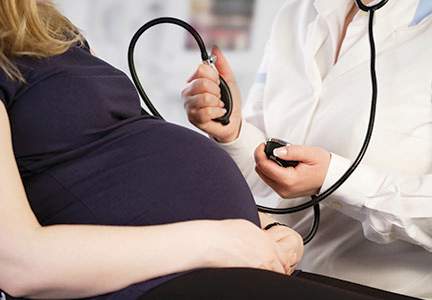User login
Glatiramer acetate didn’t affect birth outcomes in women with multiple sclerosis
Glatiramer acetate exposure during the first trimester of pregnancy appears safe and was not associated with a teratogenic effect in a nationwide German Multiple Sclerosis and Pregnancy registry.
In the second largest study of the safety of glatiramer acetate exposure during early pregnancy in multiple sclerosis patients, Sandra Herbstritt, Pharm.D., and her colleagues at Ruhr University Bochum (Germany) reported that exposure to the drug in 151 women with multiple sclerosis was not associated with significant differences in pregnancy or birth outcomes when compared with 95 controls without exposure to disease-modifying therapy (DMT) during pregnancy. All but three of the patients who took glatiramer acetate stopped it in the first trimester (median duration of 31 days; range, 0-154 days). Pregnancies were considered exposed to glatiramer acetate if the last injection was administered after the last menstrual period (Mult Scler. 2016 Jan 11. doi: 10.1177/1352458515623366).
Significantly more relapses occurred in women who did not take a DMT during pregnancy than in women who took glatiramer acetate (28 vs. 18, respectively), particularly in the first and third trimesters. A total of 224 live births occurred, including 136 with exposure to glatiramer acetate and 88 without DMT exposure. All but 3 of the 22 pregnancies that did not result in live births were spontaneous abortions in the first trimester.
The only early neonatal death among women who took glatiramer acetate involved an infant who died 30 minutes after birth in gestational week 24 because of a maternal infection. According to the investigators, “the mother received glatiramer acetate for 8 months prior to pregnancy, stopped treatment in the second [gestational week], and was not exposed to other substances during pregnancy.”
A total of nine congenital abnormalities (eight major, one minor) were observed without any specific pattern and included three in glatiramer acetate–exposed neonates and six in unexposed neonates.
No safety signals were reported for glatiramer acetate on the outcome of pregnancy, labor, or delivery in a previous meta-analysis of 97 pregnancies in eight studies. Glatiramer acetate’s manufacturer, Teva, reported no adverse outcomes in a conference abstract of 245 pregnancies exposed to glatiramer acetate, but the company has not published its postmarketing surveillance data in manuscript form, the authors wrote.
“Our results of a lacking adverse effect of glatiramer acetate during early pregnancy exposure are biologically plausible as it is very unlikely that glatiramer acetate passes the placental barrier,” the investigators wrote, because it is not permeable for a large heterogeneous mixture of polypeptides such as glatiramer acetate, which have molecular weights of 5,000-9,000 d.
The German Multiple Sclerosis and Pregnancy registry was partly supported by Bayer Healthcare, Biogen Idec Germany, Merck Serono, Novartis Pharma, Teva Pharma, and Sanofi-Aventis Genzyme Pharmaceuticals, but the sponsors had no role in the registry design, data collection, analyses, or dissemination of results. Two authors reported financial ties to numerous pharmaceutical companies that market MS drugs, and two reported support from the German Research Council. Another author is the site principal investigator for two industry-sponsored randomized clinical trials.
Glatiramer acetate exposure during the first trimester of pregnancy appears safe and was not associated with a teratogenic effect in a nationwide German Multiple Sclerosis and Pregnancy registry.
In the second largest study of the safety of glatiramer acetate exposure during early pregnancy in multiple sclerosis patients, Sandra Herbstritt, Pharm.D., and her colleagues at Ruhr University Bochum (Germany) reported that exposure to the drug in 151 women with multiple sclerosis was not associated with significant differences in pregnancy or birth outcomes when compared with 95 controls without exposure to disease-modifying therapy (DMT) during pregnancy. All but three of the patients who took glatiramer acetate stopped it in the first trimester (median duration of 31 days; range, 0-154 days). Pregnancies were considered exposed to glatiramer acetate if the last injection was administered after the last menstrual period (Mult Scler. 2016 Jan 11. doi: 10.1177/1352458515623366).
Significantly more relapses occurred in women who did not take a DMT during pregnancy than in women who took glatiramer acetate (28 vs. 18, respectively), particularly in the first and third trimesters. A total of 224 live births occurred, including 136 with exposure to glatiramer acetate and 88 without DMT exposure. All but 3 of the 22 pregnancies that did not result in live births were spontaneous abortions in the first trimester.
The only early neonatal death among women who took glatiramer acetate involved an infant who died 30 minutes after birth in gestational week 24 because of a maternal infection. According to the investigators, “the mother received glatiramer acetate for 8 months prior to pregnancy, stopped treatment in the second [gestational week], and was not exposed to other substances during pregnancy.”
A total of nine congenital abnormalities (eight major, one minor) were observed without any specific pattern and included three in glatiramer acetate–exposed neonates and six in unexposed neonates.
No safety signals were reported for glatiramer acetate on the outcome of pregnancy, labor, or delivery in a previous meta-analysis of 97 pregnancies in eight studies. Glatiramer acetate’s manufacturer, Teva, reported no adverse outcomes in a conference abstract of 245 pregnancies exposed to glatiramer acetate, but the company has not published its postmarketing surveillance data in manuscript form, the authors wrote.
“Our results of a lacking adverse effect of glatiramer acetate during early pregnancy exposure are biologically plausible as it is very unlikely that glatiramer acetate passes the placental barrier,” the investigators wrote, because it is not permeable for a large heterogeneous mixture of polypeptides such as glatiramer acetate, which have molecular weights of 5,000-9,000 d.
The German Multiple Sclerosis and Pregnancy registry was partly supported by Bayer Healthcare, Biogen Idec Germany, Merck Serono, Novartis Pharma, Teva Pharma, and Sanofi-Aventis Genzyme Pharmaceuticals, but the sponsors had no role in the registry design, data collection, analyses, or dissemination of results. Two authors reported financial ties to numerous pharmaceutical companies that market MS drugs, and two reported support from the German Research Council. Another author is the site principal investigator for two industry-sponsored randomized clinical trials.
Glatiramer acetate exposure during the first trimester of pregnancy appears safe and was not associated with a teratogenic effect in a nationwide German Multiple Sclerosis and Pregnancy registry.
In the second largest study of the safety of glatiramer acetate exposure during early pregnancy in multiple sclerosis patients, Sandra Herbstritt, Pharm.D., and her colleagues at Ruhr University Bochum (Germany) reported that exposure to the drug in 151 women with multiple sclerosis was not associated with significant differences in pregnancy or birth outcomes when compared with 95 controls without exposure to disease-modifying therapy (DMT) during pregnancy. All but three of the patients who took glatiramer acetate stopped it in the first trimester (median duration of 31 days; range, 0-154 days). Pregnancies were considered exposed to glatiramer acetate if the last injection was administered after the last menstrual period (Mult Scler. 2016 Jan 11. doi: 10.1177/1352458515623366).
Significantly more relapses occurred in women who did not take a DMT during pregnancy than in women who took glatiramer acetate (28 vs. 18, respectively), particularly in the first and third trimesters. A total of 224 live births occurred, including 136 with exposure to glatiramer acetate and 88 without DMT exposure. All but 3 of the 22 pregnancies that did not result in live births were spontaneous abortions in the first trimester.
The only early neonatal death among women who took glatiramer acetate involved an infant who died 30 minutes after birth in gestational week 24 because of a maternal infection. According to the investigators, “the mother received glatiramer acetate for 8 months prior to pregnancy, stopped treatment in the second [gestational week], and was not exposed to other substances during pregnancy.”
A total of nine congenital abnormalities (eight major, one minor) were observed without any specific pattern and included three in glatiramer acetate–exposed neonates and six in unexposed neonates.
No safety signals were reported for glatiramer acetate on the outcome of pregnancy, labor, or delivery in a previous meta-analysis of 97 pregnancies in eight studies. Glatiramer acetate’s manufacturer, Teva, reported no adverse outcomes in a conference abstract of 245 pregnancies exposed to glatiramer acetate, but the company has not published its postmarketing surveillance data in manuscript form, the authors wrote.
“Our results of a lacking adverse effect of glatiramer acetate during early pregnancy exposure are biologically plausible as it is very unlikely that glatiramer acetate passes the placental barrier,” the investigators wrote, because it is not permeable for a large heterogeneous mixture of polypeptides such as glatiramer acetate, which have molecular weights of 5,000-9,000 d.
The German Multiple Sclerosis and Pregnancy registry was partly supported by Bayer Healthcare, Biogen Idec Germany, Merck Serono, Novartis Pharma, Teva Pharma, and Sanofi-Aventis Genzyme Pharmaceuticals, but the sponsors had no role in the registry design, data collection, analyses, or dissemination of results. Two authors reported financial ties to numerous pharmaceutical companies that market MS drugs, and two reported support from the German Research Council. Another author is the site principal investigator for two industry-sponsored randomized clinical trials.
FROM MULTIPLE SCLEROSIS JOURNAL
Key clinical point: Glatiramer acetate is not associated with adverse maternal or neonatal outcomes, but nonuse of any disease-modifying therapy raises the risk of having more disease relapses.
Major finding: Exposure to glatiramer acetate in 151 women with multiple sclerosis was not associated with significant differences in pregnancy or birth outcomes when compared with 95 controls without exposure to disease-modifying therapy.
Data source: A cohort study of 246 women with multiple sclerosis who became pregnant and enrolled in a German registry.
Disclosures: The German Multiple Sclerosis and Pregnancy registry was partly supported by Bayer Healthcare, Biogen Idec Germany, Merck Serono, Novartis Pharma, Teva Pharma, and Sanofi-Aventis Genzyme Pharmaceuticals, but the sponsors had no role in the registry design, data collection, analyses, or dissemination of results. Two authors reported financial ties to numerous pharmaceutical companies that market MS drugs, and two reported support from the German Research Council. Another author is the site principal investigator for two industry-sponsored randomized clinical trials.
Zika virus: CDC warns pregnant women to avoid some tropical travel
Pregnant women and those planning to become pregnant should avoid traveling to 14 tropical countries and territories in Central and South America and the Caribbean, where there is a rapidly escalating outbreak of the mosquito-borne zika virus, according to the Centers for Disease Control & Prevention in an advisory issued Jan. 15.
The CDC advisory covers Brazil, Colombia, El Salvador, French Guiana, Guatemala, Haiti, Honduras, Martinique, Mexico, Panama, Paraguay, Suriname, Venezuela, and the Commonwealth of Puerto Rico.
Although illness due to the zika virus tends to be mild with symptoms lasting from several days to a week, research has indicated a correlation between the virus and a skyrocketing number of babies born with microcephaly and other poor outcomes in Brazil. The Brazilian Ministry of Health has declared a national health emergency (link in Portuguese) as officials there fear the numbers of cases will go higher.
“Until more is known, and out of an abundance of caution, CDC recommends special precautions for pregnant women and women trying to become pregnant,” the CDC said in a statement. Specifically, women at any trimester of pregnancy should cancel or postpone travel to the areas covered by the advisory. Any pregnant women who must travel should consult with a physician prior to travel and take great care to avoid mosquito bites. The advice should be observed by women who are thinking of becoming pregnant, according to the CDC.
The government of Canada has issued a similar travel warning for pregnant women.
CDC warns that because the mosquitoes of the Aedes aegypti species that spread zika virus are found worldwide, further outbreaks are likely in other countries. Indeed, zika virus transmission has been seen in several countries in Africa and Asia.
In December 2015, Puerto Rico reported its first confirmed zika virus case. Although zika has not been reported in the continental United States, the CDC reports there have been infected travelers returning from affected countries.
Advice for those who must travel to areas where zika virus transmission has been documented can be found on the CDC website.
On Twitter @whitneymcknight
Pregnant women and those planning to become pregnant should avoid traveling to 14 tropical countries and territories in Central and South America and the Caribbean, where there is a rapidly escalating outbreak of the mosquito-borne zika virus, according to the Centers for Disease Control & Prevention in an advisory issued Jan. 15.
The CDC advisory covers Brazil, Colombia, El Salvador, French Guiana, Guatemala, Haiti, Honduras, Martinique, Mexico, Panama, Paraguay, Suriname, Venezuela, and the Commonwealth of Puerto Rico.
Although illness due to the zika virus tends to be mild with symptoms lasting from several days to a week, research has indicated a correlation between the virus and a skyrocketing number of babies born with microcephaly and other poor outcomes in Brazil. The Brazilian Ministry of Health has declared a national health emergency (link in Portuguese) as officials there fear the numbers of cases will go higher.
“Until more is known, and out of an abundance of caution, CDC recommends special precautions for pregnant women and women trying to become pregnant,” the CDC said in a statement. Specifically, women at any trimester of pregnancy should cancel or postpone travel to the areas covered by the advisory. Any pregnant women who must travel should consult with a physician prior to travel and take great care to avoid mosquito bites. The advice should be observed by women who are thinking of becoming pregnant, according to the CDC.
The government of Canada has issued a similar travel warning for pregnant women.
CDC warns that because the mosquitoes of the Aedes aegypti species that spread zika virus are found worldwide, further outbreaks are likely in other countries. Indeed, zika virus transmission has been seen in several countries in Africa and Asia.
In December 2015, Puerto Rico reported its first confirmed zika virus case. Although zika has not been reported in the continental United States, the CDC reports there have been infected travelers returning from affected countries.
Advice for those who must travel to areas where zika virus transmission has been documented can be found on the CDC website.
On Twitter @whitneymcknight
Pregnant women and those planning to become pregnant should avoid traveling to 14 tropical countries and territories in Central and South America and the Caribbean, where there is a rapidly escalating outbreak of the mosquito-borne zika virus, according to the Centers for Disease Control & Prevention in an advisory issued Jan. 15.
The CDC advisory covers Brazil, Colombia, El Salvador, French Guiana, Guatemala, Haiti, Honduras, Martinique, Mexico, Panama, Paraguay, Suriname, Venezuela, and the Commonwealth of Puerto Rico.
Although illness due to the zika virus tends to be mild with symptoms lasting from several days to a week, research has indicated a correlation between the virus and a skyrocketing number of babies born with microcephaly and other poor outcomes in Brazil. The Brazilian Ministry of Health has declared a national health emergency (link in Portuguese) as officials there fear the numbers of cases will go higher.
“Until more is known, and out of an abundance of caution, CDC recommends special precautions for pregnant women and women trying to become pregnant,” the CDC said in a statement. Specifically, women at any trimester of pregnancy should cancel or postpone travel to the areas covered by the advisory. Any pregnant women who must travel should consult with a physician prior to travel and take great care to avoid mosquito bites. The advice should be observed by women who are thinking of becoming pregnant, according to the CDC.
The government of Canada has issued a similar travel warning for pregnant women.
CDC warns that because the mosquitoes of the Aedes aegypti species that spread zika virus are found worldwide, further outbreaks are likely in other countries. Indeed, zika virus transmission has been seen in several countries in Africa and Asia.
In December 2015, Puerto Rico reported its first confirmed zika virus case. Although zika has not been reported in the continental United States, the CDC reports there have been infected travelers returning from affected countries.
Advice for those who must travel to areas where zika virus transmission has been documented can be found on the CDC website.
On Twitter @whitneymcknight
Investigational maternal group B strep vaccine well tolerated
An investigational trivalent group B streptococcal vaccine given to pregnant women produced elevated antibody levels in their infants, indicating that the infants likely were protected by passive immunity, according to a report published online Jan. 11 in Obstetrics & Gynecology.
A maternally administered vaccine was proposed as possibly the most effective means of preventing group B strep disease “across the entire period of vulnerability in newborns.” In this phase II randomized study performed at two sites in Belgium and three in Canada, levels of GBS-specific antibodies were assessed in infants of 86 healthy women vaccinated at 24-35 weeks’ gestation.
A total of 51 women received active vaccine and 35 received a placebo injection in the 2-year trial, which was supported by Novartis Vaccines and Diagnostics, maker of this investigational vaccine, according to Dr. Gilbert G.G. Donders of Femicare Clinical Research for Women, Tienen, Belgium, and his associates.
Mean maternal antibody levels increased by 16-fold to 23-fold after vaccination. Levels of antibody transfer, as measured in cord blood samples or needlestick samples from the neonate at birth, ranged from 66% to 79% – which is comparable to levels seen after maternal immunization with other vaccines such as those against Haemophilus influenzae type b or meningococcal disease.
At 3 months of age, antibody levels in the infants had decreased to approximately 22%-25% of what they had been at birth, but this was still 5-8 times higher than antibody levels in the placebo group, the investigators reported (Obstet Gynecol. 2016;127:214-22. doi: 10.1097/AOG.0000000000001190).
Neither the mothers nor the infants showed any “concerning safety signals.” One-minute and 5-minute Apgar scores were similar between the two study groups, and the percentage of infants who achieved “normal” scores on developmental measures also was similar: 71%-96% at 5 months and 93%-100% at 7 months in both groups. One newborn developed perinatal asphyxia, “which was considered possibly related to vaccination because no other obvious cause was present,” the researchers noted.
In addition, there was a possibility that the investigational vaccine contained a compound that might interfere with the infant’s response to routine diphtheria immunization. But no such interference was detected when these responses were measured after the infants received their final diphtheria vaccination, according to the researchers.
Novartis Vaccines and Diagnostics, whose non-influenza human vaccine business was recently transferred to GlaxoSmithKline, sponsored the study. Dr. Donders received research fees for undertaking the trial, other coauthors received research funding from Novartis, and four coauthors were employed by Novartis at the time of the study.
An investigational trivalent group B streptococcal vaccine given to pregnant women produced elevated antibody levels in their infants, indicating that the infants likely were protected by passive immunity, according to a report published online Jan. 11 in Obstetrics & Gynecology.
A maternally administered vaccine was proposed as possibly the most effective means of preventing group B strep disease “across the entire period of vulnerability in newborns.” In this phase II randomized study performed at two sites in Belgium and three in Canada, levels of GBS-specific antibodies were assessed in infants of 86 healthy women vaccinated at 24-35 weeks’ gestation.
A total of 51 women received active vaccine and 35 received a placebo injection in the 2-year trial, which was supported by Novartis Vaccines and Diagnostics, maker of this investigational vaccine, according to Dr. Gilbert G.G. Donders of Femicare Clinical Research for Women, Tienen, Belgium, and his associates.
Mean maternal antibody levels increased by 16-fold to 23-fold after vaccination. Levels of antibody transfer, as measured in cord blood samples or needlestick samples from the neonate at birth, ranged from 66% to 79% – which is comparable to levels seen after maternal immunization with other vaccines such as those against Haemophilus influenzae type b or meningococcal disease.
At 3 months of age, antibody levels in the infants had decreased to approximately 22%-25% of what they had been at birth, but this was still 5-8 times higher than antibody levels in the placebo group, the investigators reported (Obstet Gynecol. 2016;127:214-22. doi: 10.1097/AOG.0000000000001190).
Neither the mothers nor the infants showed any “concerning safety signals.” One-minute and 5-minute Apgar scores were similar between the two study groups, and the percentage of infants who achieved “normal” scores on developmental measures also was similar: 71%-96% at 5 months and 93%-100% at 7 months in both groups. One newborn developed perinatal asphyxia, “which was considered possibly related to vaccination because no other obvious cause was present,” the researchers noted.
In addition, there was a possibility that the investigational vaccine contained a compound that might interfere with the infant’s response to routine diphtheria immunization. But no such interference was detected when these responses were measured after the infants received their final diphtheria vaccination, according to the researchers.
Novartis Vaccines and Diagnostics, whose non-influenza human vaccine business was recently transferred to GlaxoSmithKline, sponsored the study. Dr. Donders received research fees for undertaking the trial, other coauthors received research funding from Novartis, and four coauthors were employed by Novartis at the time of the study.
An investigational trivalent group B streptococcal vaccine given to pregnant women produced elevated antibody levels in their infants, indicating that the infants likely were protected by passive immunity, according to a report published online Jan. 11 in Obstetrics & Gynecology.
A maternally administered vaccine was proposed as possibly the most effective means of preventing group B strep disease “across the entire period of vulnerability in newborns.” In this phase II randomized study performed at two sites in Belgium and three in Canada, levels of GBS-specific antibodies were assessed in infants of 86 healthy women vaccinated at 24-35 weeks’ gestation.
A total of 51 women received active vaccine and 35 received a placebo injection in the 2-year trial, which was supported by Novartis Vaccines and Diagnostics, maker of this investigational vaccine, according to Dr. Gilbert G.G. Donders of Femicare Clinical Research for Women, Tienen, Belgium, and his associates.
Mean maternal antibody levels increased by 16-fold to 23-fold after vaccination. Levels of antibody transfer, as measured in cord blood samples or needlestick samples from the neonate at birth, ranged from 66% to 79% – which is comparable to levels seen after maternal immunization with other vaccines such as those against Haemophilus influenzae type b or meningococcal disease.
At 3 months of age, antibody levels in the infants had decreased to approximately 22%-25% of what they had been at birth, but this was still 5-8 times higher than antibody levels in the placebo group, the investigators reported (Obstet Gynecol. 2016;127:214-22. doi: 10.1097/AOG.0000000000001190).
Neither the mothers nor the infants showed any “concerning safety signals.” One-minute and 5-minute Apgar scores were similar between the two study groups, and the percentage of infants who achieved “normal” scores on developmental measures also was similar: 71%-96% at 5 months and 93%-100% at 7 months in both groups. One newborn developed perinatal asphyxia, “which was considered possibly related to vaccination because no other obvious cause was present,” the researchers noted.
In addition, there was a possibility that the investigational vaccine contained a compound that might interfere with the infant’s response to routine diphtheria immunization. But no such interference was detected when these responses were measured after the infants received their final diphtheria vaccination, according to the researchers.
Novartis Vaccines and Diagnostics, whose non-influenza human vaccine business was recently transferred to GlaxoSmithKline, sponsored the study. Dr. Donders received research fees for undertaking the trial, other coauthors received research funding from Novartis, and four coauthors were employed by Novartis at the time of the study.
FROM OBSTETRICS & GYNECOLOGY
Key clinical point: An investigational trivalent group B strep vaccine for pregnant women raised antibody levels in their infants, indicating that the infants likely were protected by passive immunity.
Major finding: Mean maternal antibody levels increased by 16-fold to 23-fold after vaccination, and levels of antibody transfer, as measured in cord blood samples or needlestick samples from the neonate at birth, ranged from 66% to 79%.
Data source: A manufacturer-sponsored phase II randomized placebo-controlled single-blinded study involving 86 healthy pregnant women in Belgium and Canada.
Disclosures: Novartis Vaccines and Diagnostics, whose non-influenza human vaccine business was recently transferred to GlaxoSmithKline, sponsored the study. Dr. Donders received research fees for undertaking the trial, other coauthors received research funding from Novartis, and four coauthors were employed by Novartis at the time of the study.
No ‘wait’ needed after early pregnancy loss
Couples who try to conceive shortly after an early pregnancy loss have a higher likelihood of a subsequent live birth than those who wait 3 months or longer to try again, according to a report published online Jan. 11 in Obstetrics & Gynecology.
“Our results indicate that there is no physiological basis for delaying pregnancy attempt after a nonectopic, nonmolar, less-than-20-week gestational age pregnancy loss. Recommendations to delay pregnancy attempts for at least 3-6 months among couples who are psychologically ready to begin trying may be unwarranted and should be revisited,” wrote Karen C. Schliep, Ph.D., of the Eunice Kennedy Shriver National Institute of Child Health and Human Development, Bethesda, Md., and her associates.
Couples who experience an early pregnancy loss often seek counseling about how long to wait before attempting to conceive again. Even though the optimal timing after a pregnancy loss that was nonectopic, nonmolar, and less than 20 weeks’ gestation has never been well studied, “many clinicians recommend waiting at least 3 months, with the World Health Organization recommending a minimum of 6 months,” the researchers wrote.
To assess pregnancy outcomes after a variety of such time intervals, they performed a secondary analysis of data from a multicenter randomized trial involving women with a history of pregnancy loss. For their analysis, the investigators focused on 1,083 women who had experienced pregnancy loss at 20 weeks or earlier.
Most women in the study (76.6%) tried again to conceive within 0-3 months, while 23.4% waited more than 3 months.
Compared with women who waited longer than 3 months to attempt to conceive again, those who didn’t wait were more likely to achieve pregnancy (68.6% vs 51.1%) and more likely to have a live birth (53.2% vs. 36.1%). Yet they were no more likely to develop pregnancy complications, including pregnancy loss, preterm birth, preeclampsia, or gestational diabetes (Obstet Gynecol. 2016;127:205-13. doi: 10.1097/AOG.0000000000001159).
While the study finds no physiological reason for couples to delay attempting to conceive after early pregnancy loss, emotional readiness is another matter. However, the researchers noted that previous studies have shown that “a speedy new pregnancy and birth of a living child lessens grief among couples who are suffering from a pregnancy loss.”
The study was supported by the Eunice Kennedy Shriver National Institute of Child Health and Human Development. Dr. Schliep and her associates reported having no relevant financial disclosures.
Couples who try to conceive shortly after an early pregnancy loss have a higher likelihood of a subsequent live birth than those who wait 3 months or longer to try again, according to a report published online Jan. 11 in Obstetrics & Gynecology.
“Our results indicate that there is no physiological basis for delaying pregnancy attempt after a nonectopic, nonmolar, less-than-20-week gestational age pregnancy loss. Recommendations to delay pregnancy attempts for at least 3-6 months among couples who are psychologically ready to begin trying may be unwarranted and should be revisited,” wrote Karen C. Schliep, Ph.D., of the Eunice Kennedy Shriver National Institute of Child Health and Human Development, Bethesda, Md., and her associates.
Couples who experience an early pregnancy loss often seek counseling about how long to wait before attempting to conceive again. Even though the optimal timing after a pregnancy loss that was nonectopic, nonmolar, and less than 20 weeks’ gestation has never been well studied, “many clinicians recommend waiting at least 3 months, with the World Health Organization recommending a minimum of 6 months,” the researchers wrote.
To assess pregnancy outcomes after a variety of such time intervals, they performed a secondary analysis of data from a multicenter randomized trial involving women with a history of pregnancy loss. For their analysis, the investigators focused on 1,083 women who had experienced pregnancy loss at 20 weeks or earlier.
Most women in the study (76.6%) tried again to conceive within 0-3 months, while 23.4% waited more than 3 months.
Compared with women who waited longer than 3 months to attempt to conceive again, those who didn’t wait were more likely to achieve pregnancy (68.6% vs 51.1%) and more likely to have a live birth (53.2% vs. 36.1%). Yet they were no more likely to develop pregnancy complications, including pregnancy loss, preterm birth, preeclampsia, or gestational diabetes (Obstet Gynecol. 2016;127:205-13. doi: 10.1097/AOG.0000000000001159).
While the study finds no physiological reason for couples to delay attempting to conceive after early pregnancy loss, emotional readiness is another matter. However, the researchers noted that previous studies have shown that “a speedy new pregnancy and birth of a living child lessens grief among couples who are suffering from a pregnancy loss.”
The study was supported by the Eunice Kennedy Shriver National Institute of Child Health and Human Development. Dr. Schliep and her associates reported having no relevant financial disclosures.
Couples who try to conceive shortly after an early pregnancy loss have a higher likelihood of a subsequent live birth than those who wait 3 months or longer to try again, according to a report published online Jan. 11 in Obstetrics & Gynecology.
“Our results indicate that there is no physiological basis for delaying pregnancy attempt after a nonectopic, nonmolar, less-than-20-week gestational age pregnancy loss. Recommendations to delay pregnancy attempts for at least 3-6 months among couples who are psychologically ready to begin trying may be unwarranted and should be revisited,” wrote Karen C. Schliep, Ph.D., of the Eunice Kennedy Shriver National Institute of Child Health and Human Development, Bethesda, Md., and her associates.
Couples who experience an early pregnancy loss often seek counseling about how long to wait before attempting to conceive again. Even though the optimal timing after a pregnancy loss that was nonectopic, nonmolar, and less than 20 weeks’ gestation has never been well studied, “many clinicians recommend waiting at least 3 months, with the World Health Organization recommending a minimum of 6 months,” the researchers wrote.
To assess pregnancy outcomes after a variety of such time intervals, they performed a secondary analysis of data from a multicenter randomized trial involving women with a history of pregnancy loss. For their analysis, the investigators focused on 1,083 women who had experienced pregnancy loss at 20 weeks or earlier.
Most women in the study (76.6%) tried again to conceive within 0-3 months, while 23.4% waited more than 3 months.
Compared with women who waited longer than 3 months to attempt to conceive again, those who didn’t wait were more likely to achieve pregnancy (68.6% vs 51.1%) and more likely to have a live birth (53.2% vs. 36.1%). Yet they were no more likely to develop pregnancy complications, including pregnancy loss, preterm birth, preeclampsia, or gestational diabetes (Obstet Gynecol. 2016;127:205-13. doi: 10.1097/AOG.0000000000001159).
While the study finds no physiological reason for couples to delay attempting to conceive after early pregnancy loss, emotional readiness is another matter. However, the researchers noted that previous studies have shown that “a speedy new pregnancy and birth of a living child lessens grief among couples who are suffering from a pregnancy loss.”
The study was supported by the Eunice Kennedy Shriver National Institute of Child Health and Human Development. Dr. Schliep and her associates reported having no relevant financial disclosures.
FROM OBSTETRICS & GYNECOLOGY
Key clinical point: Couples who try to conceive shortly after an early pregnancy loss have a higher likelihood of live birth than those who wait 3 months or longer to try again.
Major finding: Compared with women who waited longer than 3 months to attempt to conceive again, those who didn’t wait were more likely to achieve pregnancy (68.6% vs 51.1%) and more likely to have a live birth (53.2% vs. 36.1%).
Data source: A secondary analysis of data from a multicenter randomized trial involving 1,083 women with a history of early pregnancy loss.
Disclosures: The study was supported by the Eunice Kennedy Shriver National Institute of Child Health and Human Development. Dr. Schliep and her associates reported having no relevant financial disclosures.
Does poverty predetermine pediatric obesity?
WASHINGTON – Childhood obesity is soaring in the United States, especially among Hispanic and African-American children. At the heart of this “epidemic” are dietary and behavioral factors that are linked to stress and poverty rather than race and ethnicity, and the risks may even begin prenatally, according to experts attending an Institute of Medicine forum on early childhood obesity.
Based on data from the 2009-2010 NHANES (National Health and Nutrition Examination Survey), over 8% of children aged 2-5 years in the United States are obese; based on ethnicity, 18% of Hispanic boys and 15% of Hispanic girls in this age group are obese. Nearly 18% of U.S. children aged 6-11 years are obese; nearly 29% of Hispanic boys and 26% of non-Hispanic black girls in this age group are obese.
“If we’re looking for reasons why black and Hispanic children have these disparities ... then we’re looking at what happens in their early years and during pregnancy,” Dr. Elsie Taveras, chief of general academic pediatrics at Massachusetts General Hospital, Boston, said at the IOM meeting.
Chief among the culprits responsible for the “metabolic programming of risk” is the mother’s pregestational weight, according to Dr. Lisa Bodnar, associate professor of endocrinology at the University of Pittsburgh. “Children may already be programmed to become obese as a result of their intrauterine exposure to an obesogenic environment.”
A 2013 report from the Centers for Disease Control and Prevention found that about 1 in 5 women aged 20 years and older who delivered a live-born infant in 2009 were obese prior to becoming pregnant. The prevalence of obesity was highest among women who were 35 years of age and older (24%); were black, non-Hispanic (32%); had a high school education (28%); and reported Medicaid as their source of insurance coverage before pregnancy (30%). The prevalence of obesity was lowest among women who were 20-34 years of age (22%); were of “other” race/ethnicity (13%); had more than a high school education (20%); and who reported having private insurance coverage before pregnancy (20%), according to the report.
Studies have established that pre-pregnancy body mass index is highly correlated with rates of childhood obesity, but Dr. Bodnar believes the most elegant study, published in Pediatrics in 2004, links the birth records of 8,500 children born to low-income mothers in Ohio with corresponding Women, Infants, and Children data for their children’s respective weights and heights at ages 2, 3, and 4 years. Mothers with pre-pregnancy BMIs in the obese and severely obese ranges had a 3-4 times greater probability that their children had similar BMIs.
More recent U.S. data show that nearly half of all expectant mothers with normal pregravid weights also gain more weight prenatally than the IOM-recommended amounts. The tendency is even more prevalent in those with BMIs in the overweight and obese ranges: 70% of women with pre-gestational BMIs between 25 and 29.9, and 65% of those with BMIs of 30 and over gain too much weight. A 2013 meta-analysis published in JAMA correlated these weight gain patterns with a 90% increased risk of children being obese before the age of 5 years, and a 40% overall lifetime increased risk of obesity.
Stress and sociodemographic factors also can contribute to overeating and unhealthy eating, Dr. Mary Jo Messito, director of the Starting Early Child Obesity Prevention Program at Bellevue Hospital, New York, said in an interview. “High stress can lead to eating higher levels of sugary and processed food.” In lower socioeconomic neighborhoods, processed and fast foods can also be more affordable and more readily available, she added.
At least one study (Sleep Med Rev. 2012 Jun;16[3]:203-11) has established a link between later bedtimes and obesity.
This generation of children sleeps nearly a half hour less per night than did their parents, Dr. Taveras said, and the culprits include later bedtimes, the intake of caffeinated and sugary beverages, and electronic intrusions. A television left on in the room where the child sleeps can make the child dependent upon external means rather than self regulation for putting themselves to sleep, according to Dr. Taveras’ research, published in Pediatrics.
Dr. Taveras also lead a 7-year prospective prebirth cohort study (JAMA Pediatr. 2013 Aug 1;167[8]:731-8) of 1,116 mother and child dyads. In that study, the higher levels of obesity in racial and ethnic minority children were linked to modifiable risk factors. Black and Hispanic 2-year-olds were twice as likely as white ones to have had a cola or other sweetened or caffeinated drink prior to bedtime. By age 4 years, 6.4% of white children, 53% of black children, and 61% of Hispanic children in the study fell to sleep with a television on.
“Dietary patterns in the U.S. are poor, start early, and persist,” Dr. Jose M. Saavedra, chief medical officer for the nutrition division of Nestle USA, said at the meeting. Recently published data in Journal of Obesity (doi: 10.1155/2012/123023) indicate that children who consume sugar-sweetened beverages during infancy are twice as likely to consume them at age 6 years. Similarly, children who do not consume fruits and vegetables daily in infancy were also found to consume them infrequently at the age of 6.
“The patterns start much earlier than what we’ve been paying attention to,” said Dr. Saavedra. He thinks that the window of behavioral plasticity is widest at age 20 months, and urged his peers to find ways to help parents to establish good habits in their children during that time.
Discussing healthy behaviors with parents can help, and may elicit some parental behaviors that can be corrected. During the question and answer session at the meeting, for example, an audience member shared an anecdote about a mother who would only serve her children soda because she’d come from an island nation where the water supply was often unsafe.
Others noted that parents and grandparents who have grown up under conditions of food scarcity can view a “chubby” baby as a healthy baby. Mothers also can feel pressured into overfeeding infants, beginning with supplementing formula.
Also, food is often used as a quick and easy reward, Dr. Messito said. When money is tight, a cookie is an inexpensive treat.
On Twitter @whitneymcknight
WASHINGTON – Childhood obesity is soaring in the United States, especially among Hispanic and African-American children. At the heart of this “epidemic” are dietary and behavioral factors that are linked to stress and poverty rather than race and ethnicity, and the risks may even begin prenatally, according to experts attending an Institute of Medicine forum on early childhood obesity.
Based on data from the 2009-2010 NHANES (National Health and Nutrition Examination Survey), over 8% of children aged 2-5 years in the United States are obese; based on ethnicity, 18% of Hispanic boys and 15% of Hispanic girls in this age group are obese. Nearly 18% of U.S. children aged 6-11 years are obese; nearly 29% of Hispanic boys and 26% of non-Hispanic black girls in this age group are obese.
“If we’re looking for reasons why black and Hispanic children have these disparities ... then we’re looking at what happens in their early years and during pregnancy,” Dr. Elsie Taveras, chief of general academic pediatrics at Massachusetts General Hospital, Boston, said at the IOM meeting.
Chief among the culprits responsible for the “metabolic programming of risk” is the mother’s pregestational weight, according to Dr. Lisa Bodnar, associate professor of endocrinology at the University of Pittsburgh. “Children may already be programmed to become obese as a result of their intrauterine exposure to an obesogenic environment.”
A 2013 report from the Centers for Disease Control and Prevention found that about 1 in 5 women aged 20 years and older who delivered a live-born infant in 2009 were obese prior to becoming pregnant. The prevalence of obesity was highest among women who were 35 years of age and older (24%); were black, non-Hispanic (32%); had a high school education (28%); and reported Medicaid as their source of insurance coverage before pregnancy (30%). The prevalence of obesity was lowest among women who were 20-34 years of age (22%); were of “other” race/ethnicity (13%); had more than a high school education (20%); and who reported having private insurance coverage before pregnancy (20%), according to the report.
Studies have established that pre-pregnancy body mass index is highly correlated with rates of childhood obesity, but Dr. Bodnar believes the most elegant study, published in Pediatrics in 2004, links the birth records of 8,500 children born to low-income mothers in Ohio with corresponding Women, Infants, and Children data for their children’s respective weights and heights at ages 2, 3, and 4 years. Mothers with pre-pregnancy BMIs in the obese and severely obese ranges had a 3-4 times greater probability that their children had similar BMIs.
More recent U.S. data show that nearly half of all expectant mothers with normal pregravid weights also gain more weight prenatally than the IOM-recommended amounts. The tendency is even more prevalent in those with BMIs in the overweight and obese ranges: 70% of women with pre-gestational BMIs between 25 and 29.9, and 65% of those with BMIs of 30 and over gain too much weight. A 2013 meta-analysis published in JAMA correlated these weight gain patterns with a 90% increased risk of children being obese before the age of 5 years, and a 40% overall lifetime increased risk of obesity.
Stress and sociodemographic factors also can contribute to overeating and unhealthy eating, Dr. Mary Jo Messito, director of the Starting Early Child Obesity Prevention Program at Bellevue Hospital, New York, said in an interview. “High stress can lead to eating higher levels of sugary and processed food.” In lower socioeconomic neighborhoods, processed and fast foods can also be more affordable and more readily available, she added.
At least one study (Sleep Med Rev. 2012 Jun;16[3]:203-11) has established a link between later bedtimes and obesity.
This generation of children sleeps nearly a half hour less per night than did their parents, Dr. Taveras said, and the culprits include later bedtimes, the intake of caffeinated and sugary beverages, and electronic intrusions. A television left on in the room where the child sleeps can make the child dependent upon external means rather than self regulation for putting themselves to sleep, according to Dr. Taveras’ research, published in Pediatrics.
Dr. Taveras also lead a 7-year prospective prebirth cohort study (JAMA Pediatr. 2013 Aug 1;167[8]:731-8) of 1,116 mother and child dyads. In that study, the higher levels of obesity in racial and ethnic minority children were linked to modifiable risk factors. Black and Hispanic 2-year-olds were twice as likely as white ones to have had a cola or other sweetened or caffeinated drink prior to bedtime. By age 4 years, 6.4% of white children, 53% of black children, and 61% of Hispanic children in the study fell to sleep with a television on.
“Dietary patterns in the U.S. are poor, start early, and persist,” Dr. Jose M. Saavedra, chief medical officer for the nutrition division of Nestle USA, said at the meeting. Recently published data in Journal of Obesity (doi: 10.1155/2012/123023) indicate that children who consume sugar-sweetened beverages during infancy are twice as likely to consume them at age 6 years. Similarly, children who do not consume fruits and vegetables daily in infancy were also found to consume them infrequently at the age of 6.
“The patterns start much earlier than what we’ve been paying attention to,” said Dr. Saavedra. He thinks that the window of behavioral plasticity is widest at age 20 months, and urged his peers to find ways to help parents to establish good habits in their children during that time.
Discussing healthy behaviors with parents can help, and may elicit some parental behaviors that can be corrected. During the question and answer session at the meeting, for example, an audience member shared an anecdote about a mother who would only serve her children soda because she’d come from an island nation where the water supply was often unsafe.
Others noted that parents and grandparents who have grown up under conditions of food scarcity can view a “chubby” baby as a healthy baby. Mothers also can feel pressured into overfeeding infants, beginning with supplementing formula.
Also, food is often used as a quick and easy reward, Dr. Messito said. When money is tight, a cookie is an inexpensive treat.
On Twitter @whitneymcknight
WASHINGTON – Childhood obesity is soaring in the United States, especially among Hispanic and African-American children. At the heart of this “epidemic” are dietary and behavioral factors that are linked to stress and poverty rather than race and ethnicity, and the risks may even begin prenatally, according to experts attending an Institute of Medicine forum on early childhood obesity.
Based on data from the 2009-2010 NHANES (National Health and Nutrition Examination Survey), over 8% of children aged 2-5 years in the United States are obese; based on ethnicity, 18% of Hispanic boys and 15% of Hispanic girls in this age group are obese. Nearly 18% of U.S. children aged 6-11 years are obese; nearly 29% of Hispanic boys and 26% of non-Hispanic black girls in this age group are obese.
“If we’re looking for reasons why black and Hispanic children have these disparities ... then we’re looking at what happens in their early years and during pregnancy,” Dr. Elsie Taveras, chief of general academic pediatrics at Massachusetts General Hospital, Boston, said at the IOM meeting.
Chief among the culprits responsible for the “metabolic programming of risk” is the mother’s pregestational weight, according to Dr. Lisa Bodnar, associate professor of endocrinology at the University of Pittsburgh. “Children may already be programmed to become obese as a result of their intrauterine exposure to an obesogenic environment.”
A 2013 report from the Centers for Disease Control and Prevention found that about 1 in 5 women aged 20 years and older who delivered a live-born infant in 2009 were obese prior to becoming pregnant. The prevalence of obesity was highest among women who were 35 years of age and older (24%); were black, non-Hispanic (32%); had a high school education (28%); and reported Medicaid as their source of insurance coverage before pregnancy (30%). The prevalence of obesity was lowest among women who were 20-34 years of age (22%); were of “other” race/ethnicity (13%); had more than a high school education (20%); and who reported having private insurance coverage before pregnancy (20%), according to the report.
Studies have established that pre-pregnancy body mass index is highly correlated with rates of childhood obesity, but Dr. Bodnar believes the most elegant study, published in Pediatrics in 2004, links the birth records of 8,500 children born to low-income mothers in Ohio with corresponding Women, Infants, and Children data for their children’s respective weights and heights at ages 2, 3, and 4 years. Mothers with pre-pregnancy BMIs in the obese and severely obese ranges had a 3-4 times greater probability that their children had similar BMIs.
More recent U.S. data show that nearly half of all expectant mothers with normal pregravid weights also gain more weight prenatally than the IOM-recommended amounts. The tendency is even more prevalent in those with BMIs in the overweight and obese ranges: 70% of women with pre-gestational BMIs between 25 and 29.9, and 65% of those with BMIs of 30 and over gain too much weight. A 2013 meta-analysis published in JAMA correlated these weight gain patterns with a 90% increased risk of children being obese before the age of 5 years, and a 40% overall lifetime increased risk of obesity.
Stress and sociodemographic factors also can contribute to overeating and unhealthy eating, Dr. Mary Jo Messito, director of the Starting Early Child Obesity Prevention Program at Bellevue Hospital, New York, said in an interview. “High stress can lead to eating higher levels of sugary and processed food.” In lower socioeconomic neighborhoods, processed and fast foods can also be more affordable and more readily available, she added.
At least one study (Sleep Med Rev. 2012 Jun;16[3]:203-11) has established a link between later bedtimes and obesity.
This generation of children sleeps nearly a half hour less per night than did their parents, Dr. Taveras said, and the culprits include later bedtimes, the intake of caffeinated and sugary beverages, and electronic intrusions. A television left on in the room where the child sleeps can make the child dependent upon external means rather than self regulation for putting themselves to sleep, according to Dr. Taveras’ research, published in Pediatrics.
Dr. Taveras also lead a 7-year prospective prebirth cohort study (JAMA Pediatr. 2013 Aug 1;167[8]:731-8) of 1,116 mother and child dyads. In that study, the higher levels of obesity in racial and ethnic minority children were linked to modifiable risk factors. Black and Hispanic 2-year-olds were twice as likely as white ones to have had a cola or other sweetened or caffeinated drink prior to bedtime. By age 4 years, 6.4% of white children, 53% of black children, and 61% of Hispanic children in the study fell to sleep with a television on.
“Dietary patterns in the U.S. are poor, start early, and persist,” Dr. Jose M. Saavedra, chief medical officer for the nutrition division of Nestle USA, said at the meeting. Recently published data in Journal of Obesity (doi: 10.1155/2012/123023) indicate that children who consume sugar-sweetened beverages during infancy are twice as likely to consume them at age 6 years. Similarly, children who do not consume fruits and vegetables daily in infancy were also found to consume them infrequently at the age of 6.
“The patterns start much earlier than what we’ve been paying attention to,” said Dr. Saavedra. He thinks that the window of behavioral plasticity is widest at age 20 months, and urged his peers to find ways to help parents to establish good habits in their children during that time.
Discussing healthy behaviors with parents can help, and may elicit some parental behaviors that can be corrected. During the question and answer session at the meeting, for example, an audience member shared an anecdote about a mother who would only serve her children soda because she’d come from an island nation where the water supply was often unsafe.
Others noted that parents and grandparents who have grown up under conditions of food scarcity can view a “chubby” baby as a healthy baby. Mothers also can feel pressured into overfeeding infants, beginning with supplementing formula.
Also, food is often used as a quick and easy reward, Dr. Messito said. When money is tight, a cookie is an inexpensive treat.
On Twitter @whitneymcknight
EXPERT ANALYSIS FROM AN EARLY CHILDHOOD OBESITY ROUNDTABLE
Subtly elevated maternal glucose linked to increased risk of tetralogy of Fallot
ORLANDO – Subclinical elevated maternal blood glucose levels during the second trimester are strongly associated with increased risk of tetralogy of Fallot, Dr. James R. Priest reported at the American Heart Association scientific sessions.
It’s well established that maternal type 2 diabetes and gestational diabetes are strong maternal risk factors for structural congenital heart disease in their offspring. But the women in this study didn’t meet criteria for those diagnoses. They were asymptomatic, and their elevations in blood glucose in random nonfasting measurements obtained in the second trimester were below the 200 mg/dL threshold.
Thus, this study provides the first evidence that maternal blood glucose as a continuous variable is associated with increased risk of specific congenital heart defects in offspring, according to Dr. Priest, a pediatric cardiologist at Stanford (Calif.) University.
Of note, in this study of nondiabetic women, an elevated blood glucose was not associated with increased risk of d-transposition of the great arteries (dTGA), which, like tetralogy of Fallot, has been associated with maternal diabetes.
Dr. Priest presented an observational study of 277 pregnant, nondiabetic women, of whom 55 gave birth to a baby with tetralogy of Fallot, 42 had a baby with dTGA, and 180 gave birth to a baby without congenital heart disease or other malformations. Random nonfasting blood glucose and serum insulin levels were obtained from all subjects during weeks 15-18 of pregnancy.
The median maternal blood glucose level was 91.5 mg/dL in controls, similar at 90 mg/dL in the mothers of infants with dTGA, and significantly increased at 97 mg/dL in the mothers of offspring with tetralogy of Fallot. In a multivariate analysis adjusted for maternal age and ethnicity, elevated nonfasting second-trimester maternal glucose was associated with a 7.54-fold increased risk of having an infant with tetralogy of Fallot.
Maternal serum insulin level wasn’t associated with the risk of congenital heart disease.
Dr. Priest emphasized that while this study breaks new ground, the findings must be considered preliminary.
“Maternal blood glucose levels are influenced by diet, exercise, beta-cell function, and insulin resistance. Thus, blood glucose levels may simply be a marker of risk conferred by another physiologic process. The question remains whether elevated blood glucose or a variety of correlated but independent traits is behind the observed association,” he noted.
He plans to answer this key question by studying the relationship between these physiologic traits and blood glucose levels earlier in pregnancy.
This study was funded by the Stanford Cardiovascular Institute and the National Institutes of Health. Dr. Priest reported having no financial conflicts of interest.
ORLANDO – Subclinical elevated maternal blood glucose levels during the second trimester are strongly associated with increased risk of tetralogy of Fallot, Dr. James R. Priest reported at the American Heart Association scientific sessions.
It’s well established that maternal type 2 diabetes and gestational diabetes are strong maternal risk factors for structural congenital heart disease in their offspring. But the women in this study didn’t meet criteria for those diagnoses. They were asymptomatic, and their elevations in blood glucose in random nonfasting measurements obtained in the second trimester were below the 200 mg/dL threshold.
Thus, this study provides the first evidence that maternal blood glucose as a continuous variable is associated with increased risk of specific congenital heart defects in offspring, according to Dr. Priest, a pediatric cardiologist at Stanford (Calif.) University.
Of note, in this study of nondiabetic women, an elevated blood glucose was not associated with increased risk of d-transposition of the great arteries (dTGA), which, like tetralogy of Fallot, has been associated with maternal diabetes.
Dr. Priest presented an observational study of 277 pregnant, nondiabetic women, of whom 55 gave birth to a baby with tetralogy of Fallot, 42 had a baby with dTGA, and 180 gave birth to a baby without congenital heart disease or other malformations. Random nonfasting blood glucose and serum insulin levels were obtained from all subjects during weeks 15-18 of pregnancy.
The median maternal blood glucose level was 91.5 mg/dL in controls, similar at 90 mg/dL in the mothers of infants with dTGA, and significantly increased at 97 mg/dL in the mothers of offspring with tetralogy of Fallot. In a multivariate analysis adjusted for maternal age and ethnicity, elevated nonfasting second-trimester maternal glucose was associated with a 7.54-fold increased risk of having an infant with tetralogy of Fallot.
Maternal serum insulin level wasn’t associated with the risk of congenital heart disease.
Dr. Priest emphasized that while this study breaks new ground, the findings must be considered preliminary.
“Maternal blood glucose levels are influenced by diet, exercise, beta-cell function, and insulin resistance. Thus, blood glucose levels may simply be a marker of risk conferred by another physiologic process. The question remains whether elevated blood glucose or a variety of correlated but independent traits is behind the observed association,” he noted.
He plans to answer this key question by studying the relationship between these physiologic traits and blood glucose levels earlier in pregnancy.
This study was funded by the Stanford Cardiovascular Institute and the National Institutes of Health. Dr. Priest reported having no financial conflicts of interest.
ORLANDO – Subclinical elevated maternal blood glucose levels during the second trimester are strongly associated with increased risk of tetralogy of Fallot, Dr. James R. Priest reported at the American Heart Association scientific sessions.
It’s well established that maternal type 2 diabetes and gestational diabetes are strong maternal risk factors for structural congenital heart disease in their offspring. But the women in this study didn’t meet criteria for those diagnoses. They were asymptomatic, and their elevations in blood glucose in random nonfasting measurements obtained in the second trimester were below the 200 mg/dL threshold.
Thus, this study provides the first evidence that maternal blood glucose as a continuous variable is associated with increased risk of specific congenital heart defects in offspring, according to Dr. Priest, a pediatric cardiologist at Stanford (Calif.) University.
Of note, in this study of nondiabetic women, an elevated blood glucose was not associated with increased risk of d-transposition of the great arteries (dTGA), which, like tetralogy of Fallot, has been associated with maternal diabetes.
Dr. Priest presented an observational study of 277 pregnant, nondiabetic women, of whom 55 gave birth to a baby with tetralogy of Fallot, 42 had a baby with dTGA, and 180 gave birth to a baby without congenital heart disease or other malformations. Random nonfasting blood glucose and serum insulin levels were obtained from all subjects during weeks 15-18 of pregnancy.
The median maternal blood glucose level was 91.5 mg/dL in controls, similar at 90 mg/dL in the mothers of infants with dTGA, and significantly increased at 97 mg/dL in the mothers of offspring with tetralogy of Fallot. In a multivariate analysis adjusted for maternal age and ethnicity, elevated nonfasting second-trimester maternal glucose was associated with a 7.54-fold increased risk of having an infant with tetralogy of Fallot.
Maternal serum insulin level wasn’t associated with the risk of congenital heart disease.
Dr. Priest emphasized that while this study breaks new ground, the findings must be considered preliminary.
“Maternal blood glucose levels are influenced by diet, exercise, beta-cell function, and insulin resistance. Thus, blood glucose levels may simply be a marker of risk conferred by another physiologic process. The question remains whether elevated blood glucose or a variety of correlated but independent traits is behind the observed association,” he noted.
He plans to answer this key question by studying the relationship between these physiologic traits and blood glucose levels earlier in pregnancy.
This study was funded by the Stanford Cardiovascular Institute and the National Institutes of Health. Dr. Priest reported having no financial conflicts of interest.
AT THE AHA SCIENTIFIC SESSIONS
Key clinical point: Second-trimester subclinical elevated maternal blood glucose in nondiabetic women is associated with sharply increased risk of tetralogy of Fallot.
Major finding: Subtly elevated maternal blood glucose in nondiabetic women in their second trimester is associated with a 7.54-fold increased risk of tetralogy of Fallot in the baby.
Data source: This observational study involved prospectively collected data on 277 pregnant women included in California’s birth defects screening program.
Disclosures: This study was funded by the Stanford Cardiovascular Institute and the National Institutes of Health. The presenter reported having no financial conflicts of interest.
sFlt-1:PlGF assay ratio shows promise in ruling out preeclampsia
Could a better method for ruling out preeclampsia in the short term be on the way?
Using one brand of serum immunoassays measuring soluble fms-like tyrosine kinase 1 (sFlt-1) and placental growth factor (PlGF) in maternal serum, a ratio of 38 or lower appears to rule out preeclampsia among women suspected of having the disorder, with a negative predictive value of 99.3%, according to a report published online Jan. 6 in the New England Journal of Medicine.
A reliable predictor of preeclampsia is needed because women with suggestive signs or symptoms usually must be hospitalized until the disorder can be ruled out, which can take days or weeks. Circulating maternal levels of sFlt-1 are increased and those of PlGF are decreased in preeclampsia, and assessing the ratio of these two biomarkers may serve as a better risk predictor than measuring either one alone, according to Dr. Harald Zeisler of the Medical University of Vienna and his associates.
They performed a 3-year industry-sponsored prospective observational study at 30 sites in 14 countries involving women with singleton pregnancies with suspected preeclampsia.
In the first phase, involving 500 women suspected of having preeclampsia, the investigators established that a ratio cut-off point of 38 reliably distinguished the 79.8% of women who did not develop preeclampsia within 1 week from the 20.2% who did develop the condition. The second phase, involving 550 additional women suspected of having preeclampsia, validated that a ratio of 38 or lower reliably distinguished the 82.2% of women who did not develop preeclampsia from the 17.8% who did develop the condition.
In the validation cohort, the median sFlt:PlGF ratio was 87.8 in women who developed preeclampsia within 1 week and 59.4 among those who developed preeclampsia within 4 weeks. In contrast, these ratios were 8.0 and 6.3, respectively, in women who did not develop preeclampsia. The negative predictive value of an sFlt:PlGF ratio of 38 or lower was 99.3% in this cohort, while the positive predictive value – a diagnosis of preeclampsia, eclampsia, or the HELLP syndrome within 4 weeks – was 36.7% (N Engl J Med 2016 Jan 6;374:13-22. doi: 10.1056/NEJMoa1414838.).
Adding the sFlt:PlGF ratio to proteinuria and blood pressure assessments will likely help clinicians decide whether hospitalization or outpatient monitoring is the better course for such patients, the investigators wrote.
“In clinical practice, a very high negative predictive value is crucial in the evaluation of a patient with suspected preeclampsia, since failure to detect imminent disease could have devastating consequences for the fetus or the mother,” Dr. Zeisler and his associates wrote.
They noted that 38 is the optimal cutoff point only for the specific immunoassays used in this study – Elecsys, manufactured by Roche Diagnostics. Other brands of assays may have different ratio cutoffs. The findings of this observational study must also be confirmed in randomized trials to establish whether use of this ratio in clinical practice could reduce unnecessary hospitalizations and costs.
This study was funded by Roche Diagnostics, maker of the Elecsys sFlt-1 and PlGF immunoassays assessed in the study. The manufacturer also designed the study, analyzed the data, and funded a medical writer to provide assistance to the authors. Dr. Zeisler reported receiving lecture fees from Ferring and Roche Diagnostics, and his associates reported numerous ties to Roche and other industry sources.
A test that could help clinicians decide which women with suspected preeclampsia can be followed safely as outpatients versus which should be admitted to the hospital would be very beneficial. But some features of this study require careful consideration before its findings can be translated into clinical practice.
 |
Dr. Ellen W. Seely |
The assays were used only in women who had suspected preeclampsia at 24-37 weeks of gestation. It will not perform as well in unselected populations in the real world, where the likelihood of preeclampsia is low, nor in women at earlier or later weeks of gestation.
Moreover, the study participants were mostly white, and levels of these biomarkers may differ by racial or ethnic background. More than 25% were obese before pregnancy, and this study did not account for any potential variations in the relevant biomarkers related to patient weight. And the study involved only singleton pregnancies, so the results cannot be applied to women with multiple gestations, who are at the highest risk for preeclampsia.
Dr. Ellen W. Seely and Dr. Caren G. Solomon are in the division of endocrinology, diabetes, and hypertension at Brigham and Women’s Hospital, Boston. They reported having no relevant financial disclosures. These remarks are adapted from an editorial accompanying Dr. Zeisler’s report (New Engl. J. Med. 2016 Jan 6. doi: 10.1056/NEJMe1515223).
A test that could help clinicians decide which women with suspected preeclampsia can be followed safely as outpatients versus which should be admitted to the hospital would be very beneficial. But some features of this study require careful consideration before its findings can be translated into clinical practice.
 |
Dr. Ellen W. Seely |
The assays were used only in women who had suspected preeclampsia at 24-37 weeks of gestation. It will not perform as well in unselected populations in the real world, where the likelihood of preeclampsia is low, nor in women at earlier or later weeks of gestation.
Moreover, the study participants were mostly white, and levels of these biomarkers may differ by racial or ethnic background. More than 25% were obese before pregnancy, and this study did not account for any potential variations in the relevant biomarkers related to patient weight. And the study involved only singleton pregnancies, so the results cannot be applied to women with multiple gestations, who are at the highest risk for preeclampsia.
Dr. Ellen W. Seely and Dr. Caren G. Solomon are in the division of endocrinology, diabetes, and hypertension at Brigham and Women’s Hospital, Boston. They reported having no relevant financial disclosures. These remarks are adapted from an editorial accompanying Dr. Zeisler’s report (New Engl. J. Med. 2016 Jan 6. doi: 10.1056/NEJMe1515223).
A test that could help clinicians decide which women with suspected preeclampsia can be followed safely as outpatients versus which should be admitted to the hospital would be very beneficial. But some features of this study require careful consideration before its findings can be translated into clinical practice.
 |
Dr. Ellen W. Seely |
The assays were used only in women who had suspected preeclampsia at 24-37 weeks of gestation. It will not perform as well in unselected populations in the real world, where the likelihood of preeclampsia is low, nor in women at earlier or later weeks of gestation.
Moreover, the study participants were mostly white, and levels of these biomarkers may differ by racial or ethnic background. More than 25% were obese before pregnancy, and this study did not account for any potential variations in the relevant biomarkers related to patient weight. And the study involved only singleton pregnancies, so the results cannot be applied to women with multiple gestations, who are at the highest risk for preeclampsia.
Dr. Ellen W. Seely and Dr. Caren G. Solomon are in the division of endocrinology, diabetes, and hypertension at Brigham and Women’s Hospital, Boston. They reported having no relevant financial disclosures. These remarks are adapted from an editorial accompanying Dr. Zeisler’s report (New Engl. J. Med. 2016 Jan 6. doi: 10.1056/NEJMe1515223).
Could a better method for ruling out preeclampsia in the short term be on the way?
Using one brand of serum immunoassays measuring soluble fms-like tyrosine kinase 1 (sFlt-1) and placental growth factor (PlGF) in maternal serum, a ratio of 38 or lower appears to rule out preeclampsia among women suspected of having the disorder, with a negative predictive value of 99.3%, according to a report published online Jan. 6 in the New England Journal of Medicine.
A reliable predictor of preeclampsia is needed because women with suggestive signs or symptoms usually must be hospitalized until the disorder can be ruled out, which can take days or weeks. Circulating maternal levels of sFlt-1 are increased and those of PlGF are decreased in preeclampsia, and assessing the ratio of these two biomarkers may serve as a better risk predictor than measuring either one alone, according to Dr. Harald Zeisler of the Medical University of Vienna and his associates.
They performed a 3-year industry-sponsored prospective observational study at 30 sites in 14 countries involving women with singleton pregnancies with suspected preeclampsia.
In the first phase, involving 500 women suspected of having preeclampsia, the investigators established that a ratio cut-off point of 38 reliably distinguished the 79.8% of women who did not develop preeclampsia within 1 week from the 20.2% who did develop the condition. The second phase, involving 550 additional women suspected of having preeclampsia, validated that a ratio of 38 or lower reliably distinguished the 82.2% of women who did not develop preeclampsia from the 17.8% who did develop the condition.
In the validation cohort, the median sFlt:PlGF ratio was 87.8 in women who developed preeclampsia within 1 week and 59.4 among those who developed preeclampsia within 4 weeks. In contrast, these ratios were 8.0 and 6.3, respectively, in women who did not develop preeclampsia. The negative predictive value of an sFlt:PlGF ratio of 38 or lower was 99.3% in this cohort, while the positive predictive value – a diagnosis of preeclampsia, eclampsia, or the HELLP syndrome within 4 weeks – was 36.7% (N Engl J Med 2016 Jan 6;374:13-22. doi: 10.1056/NEJMoa1414838.).
Adding the sFlt:PlGF ratio to proteinuria and blood pressure assessments will likely help clinicians decide whether hospitalization or outpatient monitoring is the better course for such patients, the investigators wrote.
“In clinical practice, a very high negative predictive value is crucial in the evaluation of a patient with suspected preeclampsia, since failure to detect imminent disease could have devastating consequences for the fetus or the mother,” Dr. Zeisler and his associates wrote.
They noted that 38 is the optimal cutoff point only for the specific immunoassays used in this study – Elecsys, manufactured by Roche Diagnostics. Other brands of assays may have different ratio cutoffs. The findings of this observational study must also be confirmed in randomized trials to establish whether use of this ratio in clinical practice could reduce unnecessary hospitalizations and costs.
This study was funded by Roche Diagnostics, maker of the Elecsys sFlt-1 and PlGF immunoassays assessed in the study. The manufacturer also designed the study, analyzed the data, and funded a medical writer to provide assistance to the authors. Dr. Zeisler reported receiving lecture fees from Ferring and Roche Diagnostics, and his associates reported numerous ties to Roche and other industry sources.
Could a better method for ruling out preeclampsia in the short term be on the way?
Using one brand of serum immunoassays measuring soluble fms-like tyrosine kinase 1 (sFlt-1) and placental growth factor (PlGF) in maternal serum, a ratio of 38 or lower appears to rule out preeclampsia among women suspected of having the disorder, with a negative predictive value of 99.3%, according to a report published online Jan. 6 in the New England Journal of Medicine.
A reliable predictor of preeclampsia is needed because women with suggestive signs or symptoms usually must be hospitalized until the disorder can be ruled out, which can take days or weeks. Circulating maternal levels of sFlt-1 are increased and those of PlGF are decreased in preeclampsia, and assessing the ratio of these two biomarkers may serve as a better risk predictor than measuring either one alone, according to Dr. Harald Zeisler of the Medical University of Vienna and his associates.
They performed a 3-year industry-sponsored prospective observational study at 30 sites in 14 countries involving women with singleton pregnancies with suspected preeclampsia.
In the first phase, involving 500 women suspected of having preeclampsia, the investigators established that a ratio cut-off point of 38 reliably distinguished the 79.8% of women who did not develop preeclampsia within 1 week from the 20.2% who did develop the condition. The second phase, involving 550 additional women suspected of having preeclampsia, validated that a ratio of 38 or lower reliably distinguished the 82.2% of women who did not develop preeclampsia from the 17.8% who did develop the condition.
In the validation cohort, the median sFlt:PlGF ratio was 87.8 in women who developed preeclampsia within 1 week and 59.4 among those who developed preeclampsia within 4 weeks. In contrast, these ratios were 8.0 and 6.3, respectively, in women who did not develop preeclampsia. The negative predictive value of an sFlt:PlGF ratio of 38 or lower was 99.3% in this cohort, while the positive predictive value – a diagnosis of preeclampsia, eclampsia, or the HELLP syndrome within 4 weeks – was 36.7% (N Engl J Med 2016 Jan 6;374:13-22. doi: 10.1056/NEJMoa1414838.).
Adding the sFlt:PlGF ratio to proteinuria and blood pressure assessments will likely help clinicians decide whether hospitalization or outpatient monitoring is the better course for such patients, the investigators wrote.
“In clinical practice, a very high negative predictive value is crucial in the evaluation of a patient with suspected preeclampsia, since failure to detect imminent disease could have devastating consequences for the fetus or the mother,” Dr. Zeisler and his associates wrote.
They noted that 38 is the optimal cutoff point only for the specific immunoassays used in this study – Elecsys, manufactured by Roche Diagnostics. Other brands of assays may have different ratio cutoffs. The findings of this observational study must also be confirmed in randomized trials to establish whether use of this ratio in clinical practice could reduce unnecessary hospitalizations and costs.
This study was funded by Roche Diagnostics, maker of the Elecsys sFlt-1 and PlGF immunoassays assessed in the study. The manufacturer also designed the study, analyzed the data, and funded a medical writer to provide assistance to the authors. Dr. Zeisler reported receiving lecture fees from Ferring and Roche Diagnostics, and his associates reported numerous ties to Roche and other industry sources.
FROM THE NEW ENGLAND JOURNAL OF MEDICINE
ACR: Etanercept during pregnancy doubles the odds of major malformations
SAN FRANCISCO – Etanercept during pregnancy more than doubled the risk of major congenital malformations in a study by the Organization of Teratology Information Specialists.
The group keeps a prospective registry on exposures to biologics during pregnancy. It is finishing up its adalimumab (Humira) investigation and hasn’t found much to worry about, and continues to gather data on abatacept (Orencia), tocilizumab (Actemra), tofacitinib (Xeljanz), apremilast (Otezla), and certolizumab pegol (Cimzia).
Etanercept (Enbrel), however, seems to be a different story; major malformations turned up in the group’s recently completed investigation. Even so, Organization of Teratology Information Specialists (OTIS) investigator Dr. Christina D. Chambers, Ph.D., of the University of California, San Diego, was careful to note at the annual meeting of the American College of Rheumatology that “etanercept is not meeting the criteria for causality. There’s no pattern” in major defects and “no biological plausibility” because the drug doesn’t seem to cross the placenta when the fetus is most vulnerable to adverse outcomes.
“It is difficult to draw the conclusion that this drug is causing harm. With true teratogens, you tend to see reduced birth weights and an increased risk of spontaneous abortion, which is not the case with etanercept. We are seeing only this one finding that kind of stands alone, and everything else looks pretty good,” she said.
The etanercept study investigated pregnancy outcomes in 370 women exposed to the drug while pregnant, mostly women with rheumatoid arthritis, but also women with psoriasis and ankylosing spondylitis. Their outcomes were compared with 164 pregnant women with the same diseases but no etanercept exposure – the disease control group – and 296 healthy pregnant women.
Women in all three groups were about 33 years old on average, and about 80% were white. The women were enrolled toward the end of their first trimester. Disease severity, comorbidities, and use of vitamins, alcohol, and tobacco were similar between etanercept and disease control women. About 40% of the etanercept and disease control women, but just one in the healthy pregnancy group, were exposed to systemic corticosteroids while pregnant.
There were 33 major structural defects in children born to women taking etanercept versus 7 in the disease control group. That translated to a more than doubling of risk with etanercept (odds ratio, 2.37; 95% confidence interval, 1.02-5.52), and a more than doubling of risk versus the 10 major structural defects in children born to healthy control women (OR, 2.91; 95% CI, 1.37-6.76).
A subanalysis excluded chromosomal anomalies, but “did not [change] our conclusions,” Dr. Chambers said.
Major structural defects generally refer to problems that need a surgical fix, including spina bifida, atrial septal defects, cleft palates, hypospadias, polydactyly, and craniosynostosis.
Minor defects that don’t need surgery, like a missing earlobe, occurred in six children exposed to etanercept and showed two different patterns that involved “three specific minor malformations” not seen in either of the control groups, Dr. Chambers said. She did not elaborate on what those patterns were, but noted that the parents usually had them, too, “suggesting a genetic component as opposed to a drug effect.”
Children in the three study groups had no statistically significant differences in 1-year malignancy rates, serious infections, and hospitalizations, even when exposed to etanercept in the third trimester.
Children exposed to etanercept, however, were more likely to be born preterm and more likely to be small for gestational age in weight, length, and head circumference. They were also more likely than disease control children to screen positive for developmental issues at 1 year, but none of those differences were statistically significant.
Dr. Chambers disclosed funding from 14 companies, including Amgen, the maker of etanercept, and Janssen, Pfizer, Roche, Sanofi/Genzyme, GlaxoSmithKline, and AbbVie, the maker of adalimumab.
SAN FRANCISCO – Etanercept during pregnancy more than doubled the risk of major congenital malformations in a study by the Organization of Teratology Information Specialists.
The group keeps a prospective registry on exposures to biologics during pregnancy. It is finishing up its adalimumab (Humira) investigation and hasn’t found much to worry about, and continues to gather data on abatacept (Orencia), tocilizumab (Actemra), tofacitinib (Xeljanz), apremilast (Otezla), and certolizumab pegol (Cimzia).
Etanercept (Enbrel), however, seems to be a different story; major malformations turned up in the group’s recently completed investigation. Even so, Organization of Teratology Information Specialists (OTIS) investigator Dr. Christina D. Chambers, Ph.D., of the University of California, San Diego, was careful to note at the annual meeting of the American College of Rheumatology that “etanercept is not meeting the criteria for causality. There’s no pattern” in major defects and “no biological plausibility” because the drug doesn’t seem to cross the placenta when the fetus is most vulnerable to adverse outcomes.
“It is difficult to draw the conclusion that this drug is causing harm. With true teratogens, you tend to see reduced birth weights and an increased risk of spontaneous abortion, which is not the case with etanercept. We are seeing only this one finding that kind of stands alone, and everything else looks pretty good,” she said.
The etanercept study investigated pregnancy outcomes in 370 women exposed to the drug while pregnant, mostly women with rheumatoid arthritis, but also women with psoriasis and ankylosing spondylitis. Their outcomes were compared with 164 pregnant women with the same diseases but no etanercept exposure – the disease control group – and 296 healthy pregnant women.
Women in all three groups were about 33 years old on average, and about 80% were white. The women were enrolled toward the end of their first trimester. Disease severity, comorbidities, and use of vitamins, alcohol, and tobacco were similar between etanercept and disease control women. About 40% of the etanercept and disease control women, but just one in the healthy pregnancy group, were exposed to systemic corticosteroids while pregnant.
There were 33 major structural defects in children born to women taking etanercept versus 7 in the disease control group. That translated to a more than doubling of risk with etanercept (odds ratio, 2.37; 95% confidence interval, 1.02-5.52), and a more than doubling of risk versus the 10 major structural defects in children born to healthy control women (OR, 2.91; 95% CI, 1.37-6.76).
A subanalysis excluded chromosomal anomalies, but “did not [change] our conclusions,” Dr. Chambers said.
Major structural defects generally refer to problems that need a surgical fix, including spina bifida, atrial septal defects, cleft palates, hypospadias, polydactyly, and craniosynostosis.
Minor defects that don’t need surgery, like a missing earlobe, occurred in six children exposed to etanercept and showed two different patterns that involved “three specific minor malformations” not seen in either of the control groups, Dr. Chambers said. She did not elaborate on what those patterns were, but noted that the parents usually had them, too, “suggesting a genetic component as opposed to a drug effect.”
Children in the three study groups had no statistically significant differences in 1-year malignancy rates, serious infections, and hospitalizations, even when exposed to etanercept in the third trimester.
Children exposed to etanercept, however, were more likely to be born preterm and more likely to be small for gestational age in weight, length, and head circumference. They were also more likely than disease control children to screen positive for developmental issues at 1 year, but none of those differences were statistically significant.
Dr. Chambers disclosed funding from 14 companies, including Amgen, the maker of etanercept, and Janssen, Pfizer, Roche, Sanofi/Genzyme, GlaxoSmithKline, and AbbVie, the maker of adalimumab.
SAN FRANCISCO – Etanercept during pregnancy more than doubled the risk of major congenital malformations in a study by the Organization of Teratology Information Specialists.
The group keeps a prospective registry on exposures to biologics during pregnancy. It is finishing up its adalimumab (Humira) investigation and hasn’t found much to worry about, and continues to gather data on abatacept (Orencia), tocilizumab (Actemra), tofacitinib (Xeljanz), apremilast (Otezla), and certolizumab pegol (Cimzia).
Etanercept (Enbrel), however, seems to be a different story; major malformations turned up in the group’s recently completed investigation. Even so, Organization of Teratology Information Specialists (OTIS) investigator Dr. Christina D. Chambers, Ph.D., of the University of California, San Diego, was careful to note at the annual meeting of the American College of Rheumatology that “etanercept is not meeting the criteria for causality. There’s no pattern” in major defects and “no biological plausibility” because the drug doesn’t seem to cross the placenta when the fetus is most vulnerable to adverse outcomes.
“It is difficult to draw the conclusion that this drug is causing harm. With true teratogens, you tend to see reduced birth weights and an increased risk of spontaneous abortion, which is not the case with etanercept. We are seeing only this one finding that kind of stands alone, and everything else looks pretty good,” she said.
The etanercept study investigated pregnancy outcomes in 370 women exposed to the drug while pregnant, mostly women with rheumatoid arthritis, but also women with psoriasis and ankylosing spondylitis. Their outcomes were compared with 164 pregnant women with the same diseases but no etanercept exposure – the disease control group – and 296 healthy pregnant women.
Women in all three groups were about 33 years old on average, and about 80% were white. The women were enrolled toward the end of their first trimester. Disease severity, comorbidities, and use of vitamins, alcohol, and tobacco were similar between etanercept and disease control women. About 40% of the etanercept and disease control women, but just one in the healthy pregnancy group, were exposed to systemic corticosteroids while pregnant.
There were 33 major structural defects in children born to women taking etanercept versus 7 in the disease control group. That translated to a more than doubling of risk with etanercept (odds ratio, 2.37; 95% confidence interval, 1.02-5.52), and a more than doubling of risk versus the 10 major structural defects in children born to healthy control women (OR, 2.91; 95% CI, 1.37-6.76).
A subanalysis excluded chromosomal anomalies, but “did not [change] our conclusions,” Dr. Chambers said.
Major structural defects generally refer to problems that need a surgical fix, including spina bifida, atrial septal defects, cleft palates, hypospadias, polydactyly, and craniosynostosis.
Minor defects that don’t need surgery, like a missing earlobe, occurred in six children exposed to etanercept and showed two different patterns that involved “three specific minor malformations” not seen in either of the control groups, Dr. Chambers said. She did not elaborate on what those patterns were, but noted that the parents usually had them, too, “suggesting a genetic component as opposed to a drug effect.”
Children in the three study groups had no statistically significant differences in 1-year malignancy rates, serious infections, and hospitalizations, even when exposed to etanercept in the third trimester.
Children exposed to etanercept, however, were more likely to be born preterm and more likely to be small for gestational age in weight, length, and head circumference. They were also more likely than disease control children to screen positive for developmental issues at 1 year, but none of those differences were statistically significant.
Dr. Chambers disclosed funding from 14 companies, including Amgen, the maker of etanercept, and Janssen, Pfizer, Roche, Sanofi/Genzyme, GlaxoSmithKline, and AbbVie, the maker of adalimumab.
AT THE ACR ANNUAL MEETING
Key clinical point: Although etanercept exposure was associated with more than twofold higher odds of major structural defects, there was no pattern to the defects and no biological plausibility to etanercept causing the defects.
Major finding: There were 33 major structural defects in children born to etanercept women versus 7 in a disease comparison group, translating to a more than doubling of risk with etanercept (OR, 2.37; 95% CI, 1.02-5.52).
Data source: Prospective investigation of 830 pregnant women.
Disclosures: The presenting investigator disclosed funding from 14 companies, including Amgen, the maker of etanercept, and AbbVie, the maker of adalimumab.
Oral fluconazole raises miscarriage risk
The use of oral fluconazole during pregnancy significantly raises the risk of spontaneous abortion, according to a report published online Jan. 5 in JAMA.
In a nationwide cohort study in Denmark involving more than 1.4 million pregnancies that occurred from 1997-2013, oral fluconazole increased the risk of spontaneous abortion from 7-22 weeks gestation, compared with no exposure to fluconazole and with exposure to a topical azole.
The drug did not raise the risk of stillbirth significantly in this study, “but this outcome was relatively rare and the results were therefore imprecise,” wrote Ditte Molgaard-Nielsen of the department of epidemiology research, Statens Serum Institut, Copenhagen, and associates.
The study findings indicate that “cautious prescribing of oral fluconazole in pregnancy may be advisable,” at least until more data regarding this association become available.
Pregnant women are at increased risk for candidiasis because of hormonal changes, and the prevalence of the infection is estimated to be 10% among pregnant women in the U.S. Intravaginal topical azoles are considered first-line treatment during pregnancy, but oral fluconazole can be used instead if the patient prefers it, in recurrent cases, or if symptoms are severe.
Long-term, high-dose oral fluconazole is associated with distinct craniofacial and skeletal birth defects, and most safety studies have focused on the possible teratogenic effects of the lower doses typically used during pregnancy. Only two epidemiologic studies to date have assessed a possible association with spontaneous abortion and stillbirth, and both “may not have had sufficient power to detect even a moderately increased risk,” the investigators wrote.
To examine a possible association between oral fluconazole use and spontaneous abortion (pregnancy loss at 7-22 gestational weeks) or stillbirth (pregnancy loss at 23 weeks or later), the investigators analyzed data in a national registry of all births, stillbirths, spontaneous abortions, induced abortions, ectopic pregnancies, cases of hydatidiform mole, and all other abnormal products of gestation. They correlated this with data in registries of all hospitalizations and all prescriptions filled in Denmark, focusing on the period from 1997-2013.
There were 3,315 pregnancies in which the mother received oral fluconazole during weeks 7-22, and these were matched for propensity score and maternal age with 13,246 control pregnancies. A total of 147 spontaneous abortions occurred in the exposed group and 563 in the control group. Exposure to oral fluconazole significantly increased the risk of spontaneous abortion, with a hazard ratio (HR) of 1.48, the investigators found (JAMA. 2016 Jan;315(1):58-67. doi: 10.1001/jama.2015.17844). In a further analysis that controlled for confounding by underlying disease (vaginal candidiasis), pregnancies exposed to oral fluconazole were at significantly higher risk of spontaneous abortion compared with both pregnancies exposed to topical azoles (HR, 1.62) and those exposed to pivmecillinam (HR, 1.44).
In addition, there were 5,382 pregnancies in which the mother received oral fluconazole during weeks 23 onward, and these were matched with 21,506 control pregnancies. A total of 21 stillbirths occurred in the exposed group and 77 in the control group. The hazard ratio for stillbirth in exposed pregnancies, compared with control pregnancies, was 1.32, which was not statistically significant. However, this result should be interpreted with caution because of the small numbers in these categories, the investigators wrote.
The use of oral fluconazole during pregnancy significantly raises the risk of spontaneous abortion, according to a report published online Jan. 5 in JAMA.
In a nationwide cohort study in Denmark involving more than 1.4 million pregnancies that occurred from 1997-2013, oral fluconazole increased the risk of spontaneous abortion from 7-22 weeks gestation, compared with no exposure to fluconazole and with exposure to a topical azole.
The drug did not raise the risk of stillbirth significantly in this study, “but this outcome was relatively rare and the results were therefore imprecise,” wrote Ditte Molgaard-Nielsen of the department of epidemiology research, Statens Serum Institut, Copenhagen, and associates.
The study findings indicate that “cautious prescribing of oral fluconazole in pregnancy may be advisable,” at least until more data regarding this association become available.
Pregnant women are at increased risk for candidiasis because of hormonal changes, and the prevalence of the infection is estimated to be 10% among pregnant women in the U.S. Intravaginal topical azoles are considered first-line treatment during pregnancy, but oral fluconazole can be used instead if the patient prefers it, in recurrent cases, or if symptoms are severe.
Long-term, high-dose oral fluconazole is associated with distinct craniofacial and skeletal birth defects, and most safety studies have focused on the possible teratogenic effects of the lower doses typically used during pregnancy. Only two epidemiologic studies to date have assessed a possible association with spontaneous abortion and stillbirth, and both “may not have had sufficient power to detect even a moderately increased risk,” the investigators wrote.
To examine a possible association between oral fluconazole use and spontaneous abortion (pregnancy loss at 7-22 gestational weeks) or stillbirth (pregnancy loss at 23 weeks or later), the investigators analyzed data in a national registry of all births, stillbirths, spontaneous abortions, induced abortions, ectopic pregnancies, cases of hydatidiform mole, and all other abnormal products of gestation. They correlated this with data in registries of all hospitalizations and all prescriptions filled in Denmark, focusing on the period from 1997-2013.
There were 3,315 pregnancies in which the mother received oral fluconazole during weeks 7-22, and these were matched for propensity score and maternal age with 13,246 control pregnancies. A total of 147 spontaneous abortions occurred in the exposed group and 563 in the control group. Exposure to oral fluconazole significantly increased the risk of spontaneous abortion, with a hazard ratio (HR) of 1.48, the investigators found (JAMA. 2016 Jan;315(1):58-67. doi: 10.1001/jama.2015.17844). In a further analysis that controlled for confounding by underlying disease (vaginal candidiasis), pregnancies exposed to oral fluconazole were at significantly higher risk of spontaneous abortion compared with both pregnancies exposed to topical azoles (HR, 1.62) and those exposed to pivmecillinam (HR, 1.44).
In addition, there were 5,382 pregnancies in which the mother received oral fluconazole during weeks 23 onward, and these were matched with 21,506 control pregnancies. A total of 21 stillbirths occurred in the exposed group and 77 in the control group. The hazard ratio for stillbirth in exposed pregnancies, compared with control pregnancies, was 1.32, which was not statistically significant. However, this result should be interpreted with caution because of the small numbers in these categories, the investigators wrote.
The use of oral fluconazole during pregnancy significantly raises the risk of spontaneous abortion, according to a report published online Jan. 5 in JAMA.
In a nationwide cohort study in Denmark involving more than 1.4 million pregnancies that occurred from 1997-2013, oral fluconazole increased the risk of spontaneous abortion from 7-22 weeks gestation, compared with no exposure to fluconazole and with exposure to a topical azole.
The drug did not raise the risk of stillbirth significantly in this study, “but this outcome was relatively rare and the results were therefore imprecise,” wrote Ditte Molgaard-Nielsen of the department of epidemiology research, Statens Serum Institut, Copenhagen, and associates.
The study findings indicate that “cautious prescribing of oral fluconazole in pregnancy may be advisable,” at least until more data regarding this association become available.
Pregnant women are at increased risk for candidiasis because of hormonal changes, and the prevalence of the infection is estimated to be 10% among pregnant women in the U.S. Intravaginal topical azoles are considered first-line treatment during pregnancy, but oral fluconazole can be used instead if the patient prefers it, in recurrent cases, or if symptoms are severe.
Long-term, high-dose oral fluconazole is associated with distinct craniofacial and skeletal birth defects, and most safety studies have focused on the possible teratogenic effects of the lower doses typically used during pregnancy. Only two epidemiologic studies to date have assessed a possible association with spontaneous abortion and stillbirth, and both “may not have had sufficient power to detect even a moderately increased risk,” the investigators wrote.
To examine a possible association between oral fluconazole use and spontaneous abortion (pregnancy loss at 7-22 gestational weeks) or stillbirth (pregnancy loss at 23 weeks or later), the investigators analyzed data in a national registry of all births, stillbirths, spontaneous abortions, induced abortions, ectopic pregnancies, cases of hydatidiform mole, and all other abnormal products of gestation. They correlated this with data in registries of all hospitalizations and all prescriptions filled in Denmark, focusing on the period from 1997-2013.
There were 3,315 pregnancies in which the mother received oral fluconazole during weeks 7-22, and these were matched for propensity score and maternal age with 13,246 control pregnancies. A total of 147 spontaneous abortions occurred in the exposed group and 563 in the control group. Exposure to oral fluconazole significantly increased the risk of spontaneous abortion, with a hazard ratio (HR) of 1.48, the investigators found (JAMA. 2016 Jan;315(1):58-67. doi: 10.1001/jama.2015.17844). In a further analysis that controlled for confounding by underlying disease (vaginal candidiasis), pregnancies exposed to oral fluconazole were at significantly higher risk of spontaneous abortion compared with both pregnancies exposed to topical azoles (HR, 1.62) and those exposed to pivmecillinam (HR, 1.44).
In addition, there were 5,382 pregnancies in which the mother received oral fluconazole during weeks 23 onward, and these were matched with 21,506 control pregnancies. A total of 21 stillbirths occurred in the exposed group and 77 in the control group. The hazard ratio for stillbirth in exposed pregnancies, compared with control pregnancies, was 1.32, which was not statistically significant. However, this result should be interpreted with caution because of the small numbers in these categories, the investigators wrote.
FROM JAMA
Key clinical point: The use of oral fluconazole during pregnancy significantly raises the risk of spontaneous abortion.
Major finding: A total of 147 spontaneous abortions occurred in the 3,315 pregnancies exposed to oral fluconazole, compared with 563 in the 13,246 control pregnancies.
Data source: A nationwide Danish cohort study involving 1,405,663 pregnancies from 1997-2013.
Disclosures: This study was supported by the Danish Medical Research Council. Ditte Molgaard-Nielsen and associates reported having no relevant financial disclosures.
2016 Update on obstetrics
Some areas of obstetric care are not as clearcut as others in this time of rapid medical evolution. In this Update, we discuss 3 of them:
- management of twin gestations
- management of chronic hypertension in pregnancy
- cell-free DNA screening for fetal aneuploidy.
To our benefit, both the American College of Obstetricians and Gynecologists (ACOG) and the Society for Maternal-Fetal Medicine (SMFM) have weighed in on important aspects of these areas of obstetric care.
Society for Maternal-Fetal Medicine, Simpson LL. Twin-twin transfusion syndrome. Am J Obstet Gynecol. 2013;208(1):3–18.
Society for Maternal-Fetal Medicine. Checklists and Safety Bundles. https://www.smfm.org/mfm-practice/checklists-and-safety-bundles. Published March 2015. Accessed December 7, 2015.
American College of Obstetricians and Gynecologists. Practice bulletin No. 144. Multifetal gestations: twin, triplet, and higher-order multifetal pregnancies. Obstet Gynecol. 2014;123(5):1118–1132.
From the maternal perspective, twin pregnancies are known to have higher risks than their singleton counterparts for such complications as hypertension, preeclampsia, diabetes, hemorrhage, cesarean delivery, postpartum depression, and anemia. These complications are managed essentially the same way regardless of the number of fetuses.
From the fetal/neonatal perspective, twin gestations may carry increased risks of congenital anomalies, preterm birth, and aneuploidy, which are managed similarly to singleton gestations overall, with certain adjustments as necessary.
Twin pregnancies do have unique risks, however, that are managed differently from the time chorionicity is established until delivery. The level of risk increases as the number of chorions and amnions decreases.
A basic management plan for twin gestations consists of a number of components, elucidated below.
1. Determine chorionicity and amnionicityThis determination is most reliably performed late in the first trimester and must be done using ultrasound. The inter-twin membrane should be identified. At 11 to 14 weeks, the presence of the “lambda sign,” a triangular projection of tissue that extends from the chorionic surface, is indicative of a dichorionic pregnancy, while a “T sign” suggests a monochorionic pregnancy (sensitivities 97%–100%; specificities 98%–100%). Alternatively, demonstration of discordant genders or separate placentas may be used later in pregnancy.
2. Monitor growth every 4 weeks in dichorionic twinsDichorionic twins are, by default, diamniotic. After the anatomic survey, growth surveillance should be conducted approximately every 4 weeks.
Discordant growth usually is defined as a difference of 20% or more in weight between the twins, based on the weight of the larger twin. As an isolated finding with both fetuses of normal weight, this discordance has not been demonstrated to increase adverse outcomes. Routine antenatal surveillance is not necessarily indicated.
Fetal growth restriction of one twin or a coexisting abnormality should prompt antenatal testing and/or earlier delivery. Any maternal comorbidities such as hypertension or diabetes also would be indications for testing. Otherwise, delivery is recommended at 38 weeks’ to 38-6/7 weeks’ gestation.
After 32 weeks, the mode of delivery may be vaginal if the presenting twin is vertex and the delivery provider can perform breech extraction or internal podalic version, if necessary.
3. Monochorionic/diamniotic twins also warrant regular surveillanceThe shared placenta places these pregnancies at increased risk for twin-to-twin transfusion syndrome (TTTS), a fetal-placental imbalance in which one twin “transfuses” the other. Ten percent to 15% of monochorionic pregnancies develop TTTS, which is associated with high rates of morbidity and mortality, even when treated.
Antenatal surveillance of these pregnancies involves ultrasonography assessment every 2 weeks, starting at 16 weeks. At each examination, the deepest vertical pocket (DVP) of fluid and presence of each fetal bladder are documented. This limited assessment alternates with a growth assessment every 2 weeks. SMFM recommends this biweekly assessment until 28 weeks, then every 2 to 3 weeks until delivery.
Stage 1 TTTS is defined by the polyhydramnios/oligohydramnios sequence (DVP of one fetus <2 cm, with DVP of the other >8 cm).
Evaluation for treatment of TTTS with laser coagulation (preferred) or amnio‑reduction should take place after the diagnosis is made, along with increased fetal surveillance.
SMFM also recommends fetal echocardiography due to the 9-fold increased risk of cardiac anomalies in monochorionic pregnancies.
Other complications of monochorionic/diamniotic twins include selective fetal growth restriction (due to unequal sharing of the placenta), twin reversed arterial perfusion (TRAP) sequence, and twin anemia-polycythemia sequence (TAPS).
Antenatal surveillance of all monochorionic twins is recommended, given the increased risk of stillbirth; many centers start testing at 32 weeks’ gestation. According to ACOG, uncomplicated monochorionic/diamniotic twins should be delivered at 34 weeks’ to 37-6/7 weeks’ gestation. Fetal growth restriction or other comorbidities may prompt delivery as early as 32 weeks.
4. Know the risks of monoamniotic twin gestationsThese twins are at increased risk for intrauterine fetal death due to cord entanglement, as well as TTTS, TAPS, and fetal growth restriction. Routine growth assessment and evaluation for TTTS are similar to those for monochorionic/diamniotic twins (without the option of polyhydramnios/oligohydramnios measurement), but the overall management of these pregnancies is unknown.
Protocols may range from outpatient antenatal testing to hospitalization to 24 to 28 weeks’ gestation with daily antenatal testing or attempted continuous monitoring. Delivery by cesarean delivery is recommended at 32 to 34 weeks’ gestation.
What this EVIDENCE means for practice Monochorionic twins need specific and frequent monitoring due to significantly increased risk for both fetal and placental complications. They justify late preterm or early term delivery.
Management of chronic hypertension in pregnancy: Reserve therapy for severe hypertension
Cell-free DNA screening for fetal aneuploidy: Strengths and limitations
Some areas of obstetric care are not as clearcut as others in this time of rapid medical evolution. In this Update, we discuss 3 of them:
- management of twin gestations
- management of chronic hypertension in pregnancy
- cell-free DNA screening for fetal aneuploidy.
To our benefit, both the American College of Obstetricians and Gynecologists (ACOG) and the Society for Maternal-Fetal Medicine (SMFM) have weighed in on important aspects of these areas of obstetric care.
Society for Maternal-Fetal Medicine, Simpson LL. Twin-twin transfusion syndrome. Am J Obstet Gynecol. 2013;208(1):3–18.
Society for Maternal-Fetal Medicine. Checklists and Safety Bundles. https://www.smfm.org/mfm-practice/checklists-and-safety-bundles. Published March 2015. Accessed December 7, 2015.
American College of Obstetricians and Gynecologists. Practice bulletin No. 144. Multifetal gestations: twin, triplet, and higher-order multifetal pregnancies. Obstet Gynecol. 2014;123(5):1118–1132.
From the maternal perspective, twin pregnancies are known to have higher risks than their singleton counterparts for such complications as hypertension, preeclampsia, diabetes, hemorrhage, cesarean delivery, postpartum depression, and anemia. These complications are managed essentially the same way regardless of the number of fetuses.
From the fetal/neonatal perspective, twin gestations may carry increased risks of congenital anomalies, preterm birth, and aneuploidy, which are managed similarly to singleton gestations overall, with certain adjustments as necessary.
Twin pregnancies do have unique risks, however, that are managed differently from the time chorionicity is established until delivery. The level of risk increases as the number of chorions and amnions decreases.
A basic management plan for twin gestations consists of a number of components, elucidated below.
1. Determine chorionicity and amnionicityThis determination is most reliably performed late in the first trimester and must be done using ultrasound. The inter-twin membrane should be identified. At 11 to 14 weeks, the presence of the “lambda sign,” a triangular projection of tissue that extends from the chorionic surface, is indicative of a dichorionic pregnancy, while a “T sign” suggests a monochorionic pregnancy (sensitivities 97%–100%; specificities 98%–100%). Alternatively, demonstration of discordant genders or separate placentas may be used later in pregnancy.
2. Monitor growth every 4 weeks in dichorionic twinsDichorionic twins are, by default, diamniotic. After the anatomic survey, growth surveillance should be conducted approximately every 4 weeks.
Discordant growth usually is defined as a difference of 20% or more in weight between the twins, based on the weight of the larger twin. As an isolated finding with both fetuses of normal weight, this discordance has not been demonstrated to increase adverse outcomes. Routine antenatal surveillance is not necessarily indicated.
Fetal growth restriction of one twin or a coexisting abnormality should prompt antenatal testing and/or earlier delivery. Any maternal comorbidities such as hypertension or diabetes also would be indications for testing. Otherwise, delivery is recommended at 38 weeks’ to 38-6/7 weeks’ gestation.
After 32 weeks, the mode of delivery may be vaginal if the presenting twin is vertex and the delivery provider can perform breech extraction or internal podalic version, if necessary.
3. Monochorionic/diamniotic twins also warrant regular surveillanceThe shared placenta places these pregnancies at increased risk for twin-to-twin transfusion syndrome (TTTS), a fetal-placental imbalance in which one twin “transfuses” the other. Ten percent to 15% of monochorionic pregnancies develop TTTS, which is associated with high rates of morbidity and mortality, even when treated.
Antenatal surveillance of these pregnancies involves ultrasonography assessment every 2 weeks, starting at 16 weeks. At each examination, the deepest vertical pocket (DVP) of fluid and presence of each fetal bladder are documented. This limited assessment alternates with a growth assessment every 2 weeks. SMFM recommends this biweekly assessment until 28 weeks, then every 2 to 3 weeks until delivery.
Stage 1 TTTS is defined by the polyhydramnios/oligohydramnios sequence (DVP of one fetus <2 cm, with DVP of the other >8 cm).
Evaluation for treatment of TTTS with laser coagulation (preferred) or amnio‑reduction should take place after the diagnosis is made, along with increased fetal surveillance.
SMFM also recommends fetal echocardiography due to the 9-fold increased risk of cardiac anomalies in monochorionic pregnancies.
Other complications of monochorionic/diamniotic twins include selective fetal growth restriction (due to unequal sharing of the placenta), twin reversed arterial perfusion (TRAP) sequence, and twin anemia-polycythemia sequence (TAPS).
Antenatal surveillance of all monochorionic twins is recommended, given the increased risk of stillbirth; many centers start testing at 32 weeks’ gestation. According to ACOG, uncomplicated monochorionic/diamniotic twins should be delivered at 34 weeks’ to 37-6/7 weeks’ gestation. Fetal growth restriction or other comorbidities may prompt delivery as early as 32 weeks.
4. Know the risks of monoamniotic twin gestationsThese twins are at increased risk for intrauterine fetal death due to cord entanglement, as well as TTTS, TAPS, and fetal growth restriction. Routine growth assessment and evaluation for TTTS are similar to those for monochorionic/diamniotic twins (without the option of polyhydramnios/oligohydramnios measurement), but the overall management of these pregnancies is unknown.
Protocols may range from outpatient antenatal testing to hospitalization to 24 to 28 weeks’ gestation with daily antenatal testing or attempted continuous monitoring. Delivery by cesarean delivery is recommended at 32 to 34 weeks’ gestation.
What this EVIDENCE means for practice Monochorionic twins need specific and frequent monitoring due to significantly increased risk for both fetal and placental complications. They justify late preterm or early term delivery.
Management of chronic hypertension in pregnancy: Reserve therapy for severe hypertension
Cell-free DNA screening for fetal aneuploidy: Strengths and limitations
Some areas of obstetric care are not as clearcut as others in this time of rapid medical evolution. In this Update, we discuss 3 of them:
- management of twin gestations
- management of chronic hypertension in pregnancy
- cell-free DNA screening for fetal aneuploidy.
To our benefit, both the American College of Obstetricians and Gynecologists (ACOG) and the Society for Maternal-Fetal Medicine (SMFM) have weighed in on important aspects of these areas of obstetric care.
Society for Maternal-Fetal Medicine, Simpson LL. Twin-twin transfusion syndrome. Am J Obstet Gynecol. 2013;208(1):3–18.
Society for Maternal-Fetal Medicine. Checklists and Safety Bundles. https://www.smfm.org/mfm-practice/checklists-and-safety-bundles. Published March 2015. Accessed December 7, 2015.
American College of Obstetricians and Gynecologists. Practice bulletin No. 144. Multifetal gestations: twin, triplet, and higher-order multifetal pregnancies. Obstet Gynecol. 2014;123(5):1118–1132.
From the maternal perspective, twin pregnancies are known to have higher risks than their singleton counterparts for such complications as hypertension, preeclampsia, diabetes, hemorrhage, cesarean delivery, postpartum depression, and anemia. These complications are managed essentially the same way regardless of the number of fetuses.
From the fetal/neonatal perspective, twin gestations may carry increased risks of congenital anomalies, preterm birth, and aneuploidy, which are managed similarly to singleton gestations overall, with certain adjustments as necessary.
Twin pregnancies do have unique risks, however, that are managed differently from the time chorionicity is established until delivery. The level of risk increases as the number of chorions and amnions decreases.
A basic management plan for twin gestations consists of a number of components, elucidated below.
1. Determine chorionicity and amnionicityThis determination is most reliably performed late in the first trimester and must be done using ultrasound. The inter-twin membrane should be identified. At 11 to 14 weeks, the presence of the “lambda sign,” a triangular projection of tissue that extends from the chorionic surface, is indicative of a dichorionic pregnancy, while a “T sign” suggests a monochorionic pregnancy (sensitivities 97%–100%; specificities 98%–100%). Alternatively, demonstration of discordant genders or separate placentas may be used later in pregnancy.
2. Monitor growth every 4 weeks in dichorionic twinsDichorionic twins are, by default, diamniotic. After the anatomic survey, growth surveillance should be conducted approximately every 4 weeks.
Discordant growth usually is defined as a difference of 20% or more in weight between the twins, based on the weight of the larger twin. As an isolated finding with both fetuses of normal weight, this discordance has not been demonstrated to increase adverse outcomes. Routine antenatal surveillance is not necessarily indicated.
Fetal growth restriction of one twin or a coexisting abnormality should prompt antenatal testing and/or earlier delivery. Any maternal comorbidities such as hypertension or diabetes also would be indications for testing. Otherwise, delivery is recommended at 38 weeks’ to 38-6/7 weeks’ gestation.
After 32 weeks, the mode of delivery may be vaginal if the presenting twin is vertex and the delivery provider can perform breech extraction or internal podalic version, if necessary.
3. Monochorionic/diamniotic twins also warrant regular surveillanceThe shared placenta places these pregnancies at increased risk for twin-to-twin transfusion syndrome (TTTS), a fetal-placental imbalance in which one twin “transfuses” the other. Ten percent to 15% of monochorionic pregnancies develop TTTS, which is associated with high rates of morbidity and mortality, even when treated.
Antenatal surveillance of these pregnancies involves ultrasonography assessment every 2 weeks, starting at 16 weeks. At each examination, the deepest vertical pocket (DVP) of fluid and presence of each fetal bladder are documented. This limited assessment alternates with a growth assessment every 2 weeks. SMFM recommends this biweekly assessment until 28 weeks, then every 2 to 3 weeks until delivery.
Stage 1 TTTS is defined by the polyhydramnios/oligohydramnios sequence (DVP of one fetus <2 cm, with DVP of the other >8 cm).
Evaluation for treatment of TTTS with laser coagulation (preferred) or amnio‑reduction should take place after the diagnosis is made, along with increased fetal surveillance.
SMFM also recommends fetal echocardiography due to the 9-fold increased risk of cardiac anomalies in monochorionic pregnancies.
Other complications of monochorionic/diamniotic twins include selective fetal growth restriction (due to unequal sharing of the placenta), twin reversed arterial perfusion (TRAP) sequence, and twin anemia-polycythemia sequence (TAPS).
Antenatal surveillance of all monochorionic twins is recommended, given the increased risk of stillbirth; many centers start testing at 32 weeks’ gestation. According to ACOG, uncomplicated monochorionic/diamniotic twins should be delivered at 34 weeks’ to 37-6/7 weeks’ gestation. Fetal growth restriction or other comorbidities may prompt delivery as early as 32 weeks.
4. Know the risks of monoamniotic twin gestationsThese twins are at increased risk for intrauterine fetal death due to cord entanglement, as well as TTTS, TAPS, and fetal growth restriction. Routine growth assessment and evaluation for TTTS are similar to those for monochorionic/diamniotic twins (without the option of polyhydramnios/oligohydramnios measurement), but the overall management of these pregnancies is unknown.
Protocols may range from outpatient antenatal testing to hospitalization to 24 to 28 weeks’ gestation with daily antenatal testing or attempted continuous monitoring. Delivery by cesarean delivery is recommended at 32 to 34 weeks’ gestation.
What this EVIDENCE means for practice Monochorionic twins need specific and frequent monitoring due to significantly increased risk for both fetal and placental complications. They justify late preterm or early term delivery.
Management of chronic hypertension in pregnancy: Reserve therapy for severe hypertension
Cell-free DNA screening for fetal aneuploidy: Strengths and limitations
In this article
- Know the risks of monoamniotic twin gestations
- “Less tight” versus “tight” BP control
- Cell-free DNA screening for aneuploidy



















